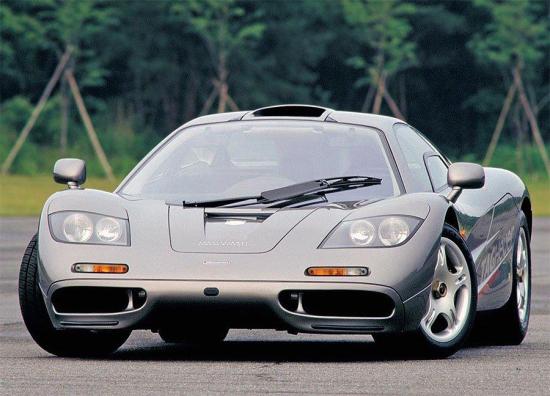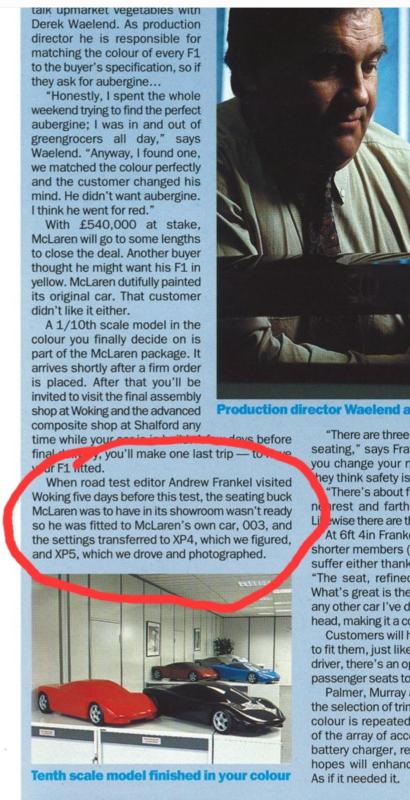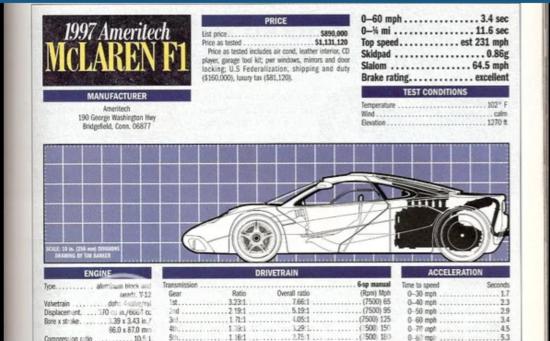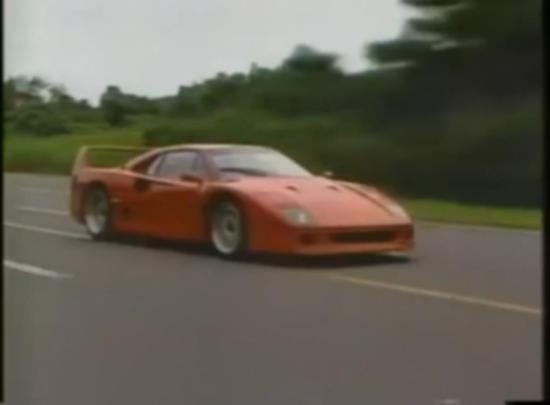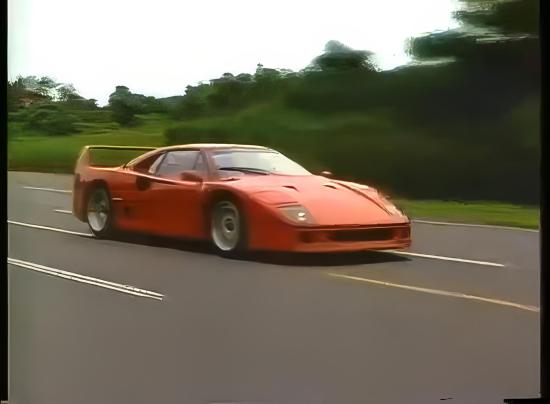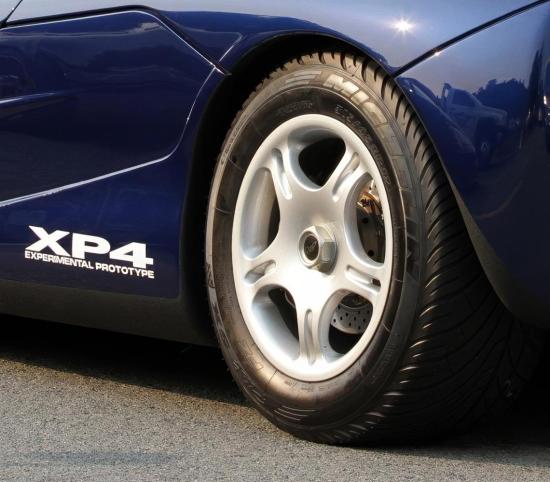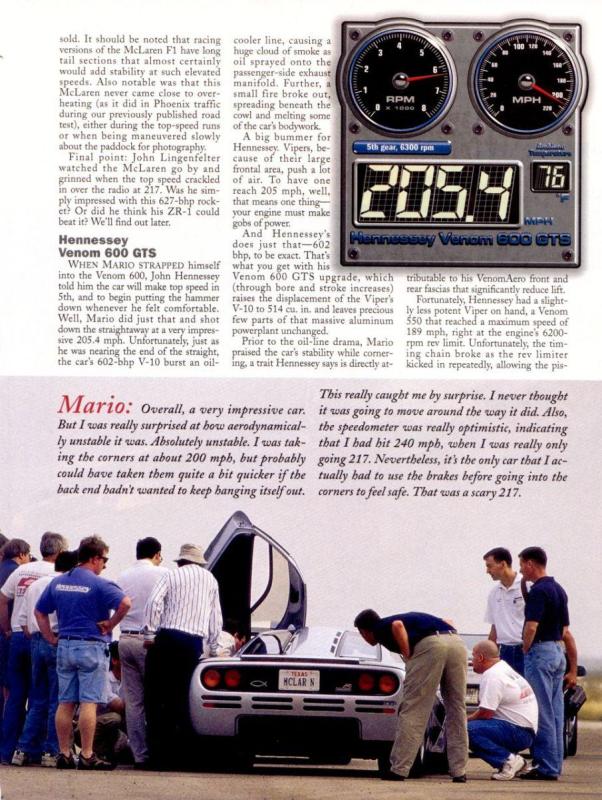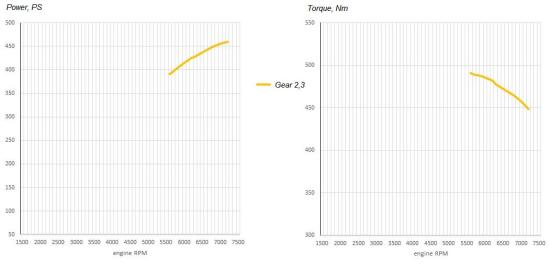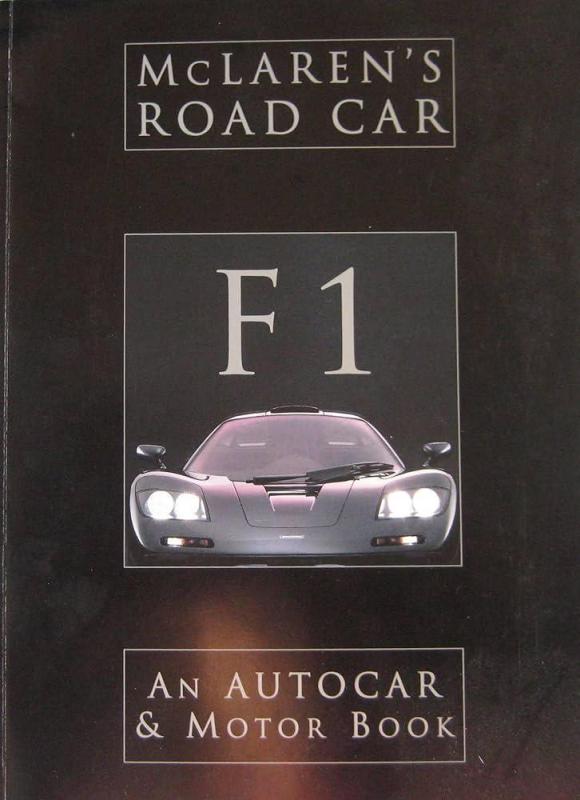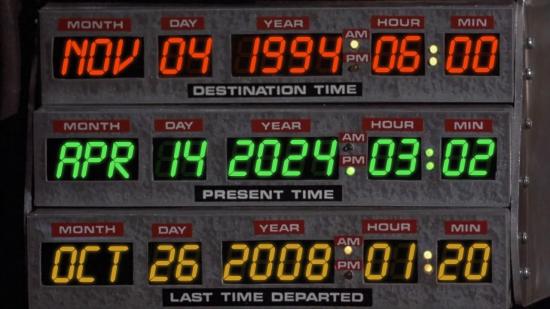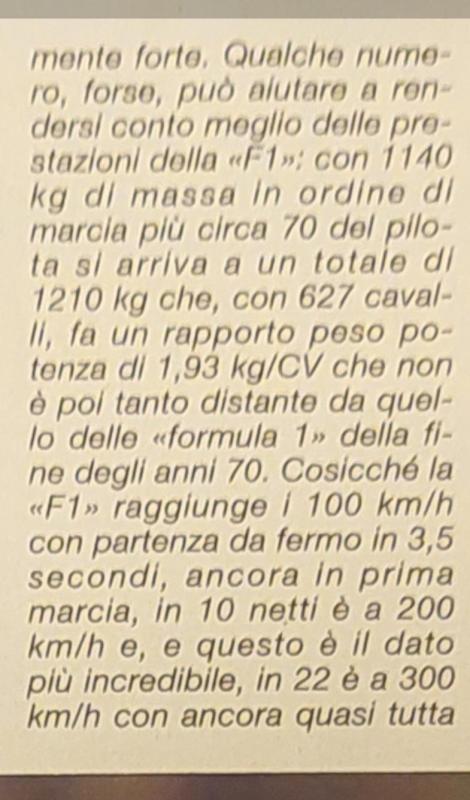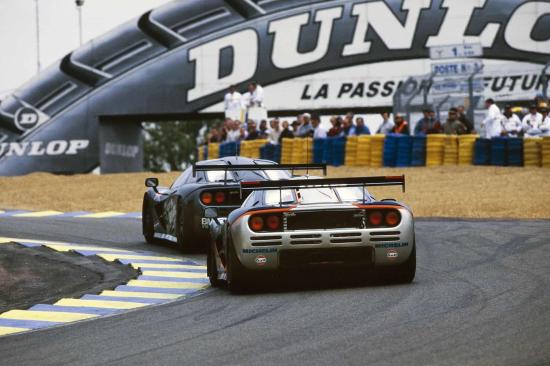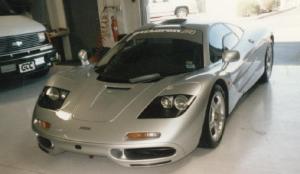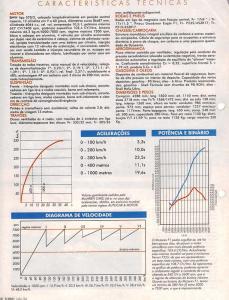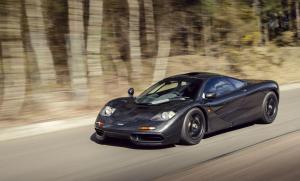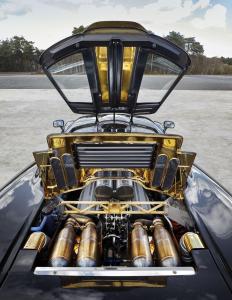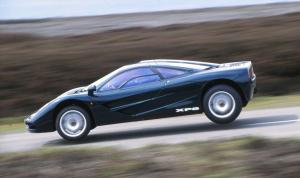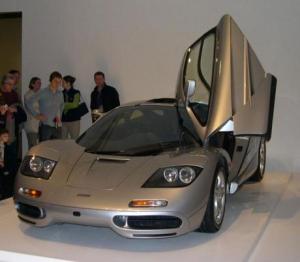This car is the most popular car on FastestLaps.com; its even more popular than the AMG ONE.
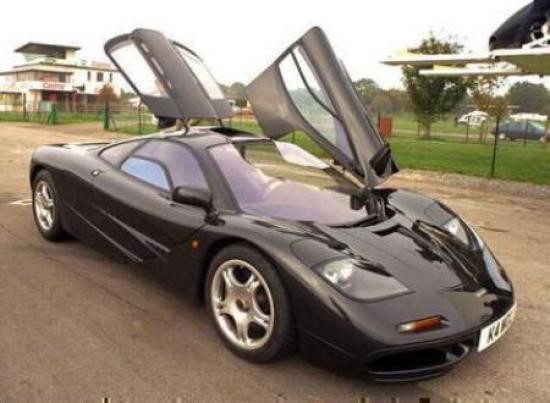
McLaren F1 specs
| Car type | Coupe |
| Curb weight | 1140-1288 kg (2513-2840 lbs) |
| Dimensions | 4.29 m (169 in) long, 1.82 m (72 in) wide, 1.14 m (45 in) high |
| Wheelbase | 2.72 m (107 in) |
| Introduced | 1993 |
| Origin country | United Kingdom |
| Gas mileage | 20.4 l/100 km (12 mpg US / 14 mpg UK) |
| Views | 156k |
Lap times
| Track | Time |
|---|---|
| Bedford Autodrome West Circuit (2004 - 06/2008) | 1:21.20 |
| Estoril | 1:55.90 |
| Tsukuba | 1:04.62 |
| Nürburgring Nordschleife | 7:18.00 est |
| Laguna Seca (post 1988) | 1:32.00 est |
| Hockenheim Short | 1:07.00 est |
| Sachsenring | 1:30.00 est |
Acceleration (kph)
| 0 - 40 kph | 1.5 s |
| 0 - 50 kph | 1.8 s |
| 0 - 60 kph | 2.1 s |
| 0 - 80 kph | 2.7 s |
| 0 - 100 kph | 3.2 s |
| 0 - 120 kph | 4.3 s |
| 0 - 140 kph | 5.1 s |
| 0 - 160 kph | 6.3 s |
| 0 - 180 kph | 7.3 s |
| 0 - 200 kph | 8.8 s |
| 0 - 220 kph | 10.1 s |
| 0 - 240 kph | 12.2 s |
| 0 - 260 kph | 14.1 s |
| 0 - 280 kph | 16.9 s |
| 0 - 300 kph | 20.3 s |
| 100 m | 5.0 s @ 139.0 kph |
| 1000 m | 19.0 s @ 292.0 kph |
| Est. 100 - 140 kph | 1.7 s |
| Est. 100 - 200 kph | 5.7 s |
| Est. 200 - 300 kph | 12.1 s |
Acceleration (mph)
| 0 - 30 mph | 1.7 s |
| 0 - 40 mph | 2.3 s |
| 0 - 50 mph | 2.9 s |
| 0 - 60 mph | 3.2 s |
| 0 - 70 mph | 3.9 s |
| 0 - 80 mph | 4.5 s |
| 0 - 90 mph | 5.6 s |
| 0 - 100 mph | 6.3 s |
| 0 - 110 mph | 7.2 s |
| 0 - 120 mph | 9.2 s |
| 0 - 130 mph | 10.4 s |
| 0 - 140 mph | 11.2 s |
| 0 - 150 mph | 12.8 s |
| 0 - 160 mph | 14.6 s |
| 0 - 170 mph | 17.2 s |
| 0 - 180 mph | 20.3 s |
| 0 - 200 mph | 28.0 s |
| Est. 1/8 mile | 7.5 s @ 110.6 mph |
| 1/4 mile | 10.8 s @ 142.3 mph |
| Est. 1/2 mile | 17.2 s @ 173.4 mph |
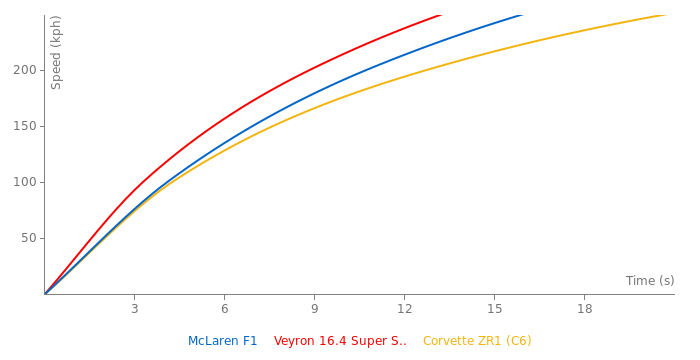
General performance
| Top speed | 391 kph (243 mph) |
| Est. max acceleration | 0.87 g (8 m/s²) |
| Lateral acceleration | 0.86 g (8 m/s²) |
| 60 mph - 0 | 39 m (127 ft) |
| 70 mph - 0 | 49 m (162 ft) |
| Noise @ idle | 66 dB |
| Noise @ 50 mph | 76 dB |
| Noise @ 70 mph | 78 dB |
Powertrain specs
| Engine type | BMW V12 |
| Displacement | 6.1 l (372 ci) |
| Power | 627 ps (618 bhp / 461 kw) |
| Torque | 647 Nm (477 lb-ft) |
| Power / liter | 103 ps (101 hp) |
| Power / weight | 523 ps (516 bhp) / t |
| Torque / weight | 540 Nm (398 lb-ft) / t |
| Efficiency | 31 PS per l/100 km |
| Transmission | 6 speed |
| Layout | middle engine, rear wheel drive |
F1 competition
FastestLaps 2w ago
That's only according to what is trending right now. In overall views I think original R35 GTR has the most, followed by E92 M3 I think.
RickyAstle98 2w ago
For those who still thinking about 20.3 seconds to 300KPH
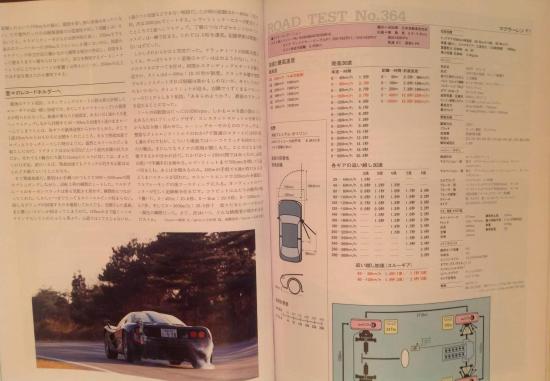
The acceleration testing session was done w/passenger w/6mph tailwinds and propably half fuel tank, Japanese loves doing that! Just think about, how cold air and 3% downhill can make a difference for 600HP/1200KG car?
Japanese logic > minus 0.3 to higher numbers as rollout (compensation)
300-320kph@4.6s
0-300kph@20.6s
0-320kph@25.2s
300-320kph @ 4.6s
VOILA
Crispi74 1m ago
French Sport Auto tested the same F1 that was tested by CarGraphic:
0-100 kph 3.3s
400m 11.1s
1000m 19.6s
100-140 kph 5th gear 3.3s
100-140 kph 6th gear 4.5s
Top speed 371 kph (factory data)
Weight checked 1263 kgs
the car seems slower than when tested the day by CG.
0-100 kph 3.7s
400m 10.8s
1000m 19.0s
100-140 kph 5th gear 3.2s
100-140 kph 6th gear 4.8s
wallenieswiftie 1w ago
those are the same acceleration times tested by Autocar&Motor, Turbo Magazine, and Car&Driver
Elias 240 1w ago @wallenieswiftie
Try to drink more water to stay hydrated or you will turn into this

ian 2m ago
my dream car has always been the McLaren F1GTR. i have devoted over 10 years to researching the stats of this car. this website is by far the best helper to me.

Thiago_Lins 5m ago
A question arose: were the McLaren XP5 and F1 different?
The performance figures obtained in tests with the XP5 chassis are much better than those presented by the "normal" F1.
McLaren F1 XP5, Car and Driver, 1994 (Autocar & Motor)
0-60 mph 3.2s
0-100 mph 6.3s
0-120 mph 9.2s
1/4-Mile 11.1s @ 138 mph
McLaren F1, Road & Track, 1997:
0-60 mph 3.4s
0-100 mph 7.7s
0-120 mph 10.5s (+1.3s) 😐
1/4-Mile 11.6s @ 125 mph (-13 mph) 🙃
The difference appears to be because of a much stronger spec (XP5). Would changing from a European to an American version hurt performance that much?
(sorry for my English) 👍
BMWX5M 5m ago
Autocar were supplied with a Mclaren F1 for the only ever Official testing. XP5 was that only example.
From memory she has 627hp but BMW V12 M engine from one to another could be plus or minus many horses and some engines will have been stronger than others.
As for the United States of America specifications models these were definitely, although thats from memory, different for Federal rules and regulations. I'd expect perhaps more stringent catalytic converter rules.
Regardless the Autocar figures stand and the Japanese figures were apparently quicker some state.
BMWX5M 5m ago @196ss
https://www.autocar.co.uk/car-news/features/autocars-exclusive-mclaren-f1-road-test-30-years
"From our point of view, XP5 is the car. Although our road test actually involved three F1s (XP4, XP5 and production car 003), XP5 was the car we drove for hundreds of miles and on which our entire evaluation was based. It’s not quite the world’s most valuable F1, for that honour belongs to the 1995 Le Mans-winning F1 GTR, but its insurable value is quoted as £25 million. What’s more, it has been woken from a three-year sleep for this story. I am excited beyond words that I might drive it again but, curiously because I’m not as nice as this sounds, I’m even more excited for my colleagues who have yet to drive one. But then F1s do make you think in curious ways. "
Looks like we were both right and wrong! LOL!
30 years on and still she's giving her secrets up! GOAT.
196ss 5m ago @BMWX5M
Yeah, curiously it looks like at the time XP4 seemed to have a bit less power than the production car. 609 PS was said, but probably it was a bit lighter. Tiff Needell later tested XP4 at Goodwood:
And we all know about the XP5. Later it turned into a monster, which with Andy Wallace at the wheel accelerated 200-300 kph in 10 seconds and had a top speed of 240+ mph.
Crispi74 1m ago @196ss
The XP4 was fitted with a non definitive engine that was dynoed new at 607PS. The XP4 was weighed 1067 kg at dry, it was a bit lighter than the production figures later. From to be new and when Autocar tested it the engine accumulated miles and enough power that seemed fast as the XP5 when new.
Crispi74 1m ago @196ss
I know what you mean, but look better at what happened later. Palmer did 120-140 mph 2.3s with 4th gear fitted.
I doubt he did 120-140 mph 2s with a shifthing 3rd to 4th gear included. Looking at that, I'm more inclined to think he shifthed in 4th gear just before 120mph. Basically datapanel shifthing points were uncorrelated with top speed gears.
Crispi74 1m ago @196ss
When a powerful car like this has the power peak so close to the limiter, it's always not easy to get the right shifthing time, expecially on lower gears because everything happens fast. Rev needle jump high so quickly.
I think that XP4 engine had a very good mid range rpm that I think at least it compensated for the final result.
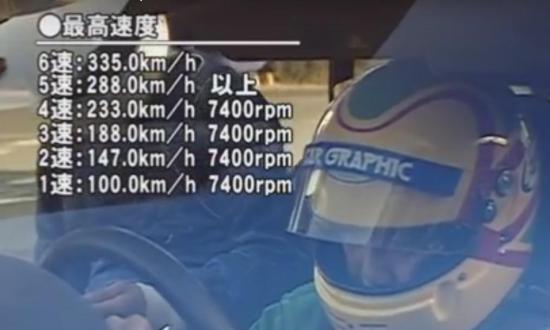
If we take a look at CarGraphic gearspeed list, it seems that shifthing in 4th at 188 kph (117mph) we are still within correct 3rd gear power band.
This is to say that I'm confident on Palmer worked fine to exctract the performance that day at the wheel of the XP4 as not necessary that engine to run closer to the limiter.
196ss 1m ago @Crispi74
I'm just trying to estimate 0-200 kph time based on the Autocar data. If we just extrapolate, we get something like 9.8, but if we take the early slow shifting out of the equation we get something like 8.8-8.9.
I'm confident on Palmer worked fine to exctract the performance that day at the wheel of the XP4 as not necessary that engine to run closer to the limiter.
In that respect, yes, but the gear switching itself is quite long in time. Compare:
Autocar - 110-120 mph including shift - 2.0 sec
Cargraphic - 112-125mph including shift - 1.5 sec
Apparently F1 generally pulls better in the CG test. But still, it seems to me that this 110-120 section could have been improved by half a second at least.
RickyAstle98 1m ago @Crispi74
Dont watch gearspeed list, magazines sometimes doing a typo errors too much, even with new cars, with available gear ratios and different tests, too many variance!
Crispi74 1m ago @RickyAstle98
Certainly, I know. Concerning power I would imagine that power increase well over running in was completed unless at 15000 miles the power was already dropping down for the 6.1l Bmw engine. Does not make sense for the Mclaren send an underperformaced car when they had already XP5 with definive engine unit available, that deliver exactly 627. That's imo.
196ss 1m ago @Crispi74
So do you think XP4 was delivering 607PS during tested? Cargraphic was quoted at 627PS?
I think so, but the difference in power is largely offset by the light weight of the XP4. I think such a better performance in the CG test is probably due more to external factors. English testing facilities are notoriously windy and bumpy.
Honestly, I'm somehow confused that the CG acceleration was apparently measured with a passenger. So there was actually some room for improvement
196ss 1m ago @Crispi74
In 1994, Portuguese magazine Turbo tested the XP5 at Estoril.
They also gave straight line acceleration figures, but there was the following hint below:
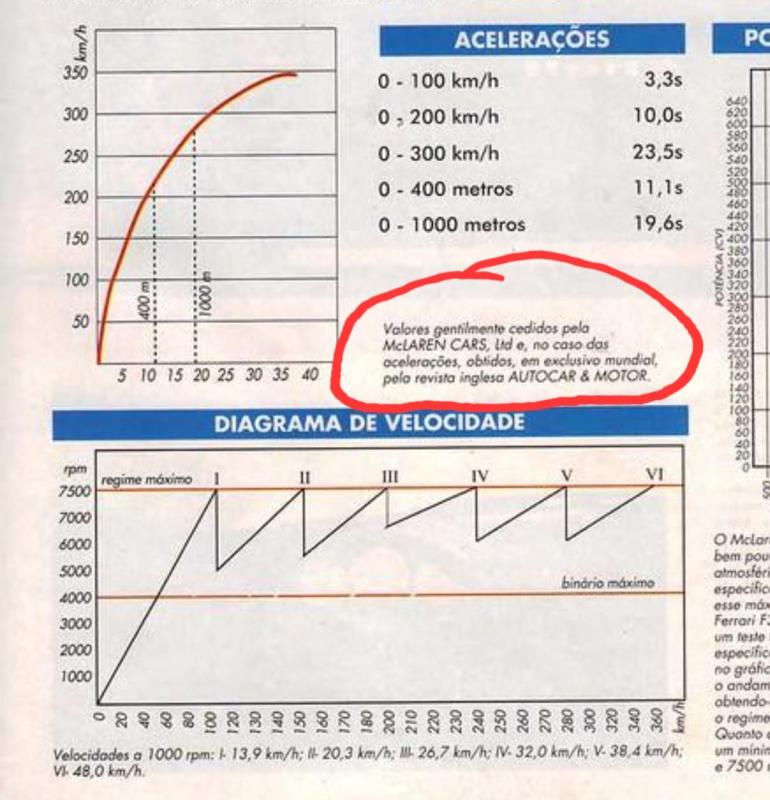
Which translated means:
"Figures courtesy of McLaren cars, Ltd and, in the case of acceleration, obtained exclusively worldwide by the British magazine AUTOCAR & MOTOR."
So my reasonable question is, is it clear from the text of the article that Autozeitung actually got these figures by their own measurements, or is it also some kind of interpretation of the Autocar&Motor XP4 acceleration graph?
The numbers looks very similar.
Crispi74 1m ago @196ss
My interpretation and my question is the same from the beghinning. I can be wrong. I cannot exclude. That's the following:
When Mclaren choosed to made the one and the only test (that seems unthrue later, unofficially the car was then tested more than one time) of the car, they decided to use Autocar as way of sharing their official performance. They had few cars available at the time, XP3, XP4 XP5 and one of th early production cars, but yes definitve engines were already fitted in the cars. We are sure that XP5 was completed from long with a engine officially delivering 627PS, that was the power figure that Rosche intended to be claimed for his engines.
https://ibb.co/2v1mSJT
Now my question is, we all knows that XP4 was delivered with a non definitive spec engine, yes, the XP5 was brand new but why in McLaren did they hijack the choice to test the XP4? https://apex.custodian.club/content/images/2020/07/19---AutoCar.jpg
Looking at how AZ saw XP5 was fast, article seems clear they has own acceleration figured the XP5, I always get at that the main reasonable reason. XP4 was reasonably the best choice to made acceleration figures, because Mclaren knows it was faster. As you know, I don't use calculations but that's the only easiest answer can do a person using a bit of reasoning. I don't think to have wrong on that...That's all I can say.
Autocar&Motor XP4 acceleration graph?
The numbers looks very similar.
Officially Autocar figures translated in km/h were the following and frequently reported:
https://ibb.co/jrLcSMy
https://ibb.co/4gNgbcj
0-100 kph 3.3-3.4
0-200 kph 9.4-9.6
0-300 kph 22.3-22.4
That's a reason why AZ numbers are more than clue that suggested that they personally tested the car, AZ seems to reported numbers refferred to the XP5 in person.. I don't know how Turbo magazine numbers comes from, if they translated numbers or something other, the only sure thing is that from that period XP5 car was the car then choosed to be sent to press to be driven, instead to be photographed.
Autozeitung said in the article: https://ibb.co/7GwDYbR
"It achieves zero to 100 km/h in 3.6 seconds, zero to 200 km/h in 9.9 seconds, zero to 300 km/h in 23 seconds. Top speeds of 370 km/h are possible, but not on a day like today. go on Even when the track dries out, it only takes the blink of an eye to reach 300 km/h. The engine doesn't turn 6000 rpm in sixth gear. Thanks to the good aerodynamics (drag value 0.32) and the low weight (1138 kilos), the three-seater accelerates above 160 km/h faster than a Formula 1 racing car"
Here the data panel: https://ibb.co/Z8LRKcB
When Motor Revue from AMuS published the comparison with a young an still in grey color XP4 at the side of the Walkinshaw XJ220, the F1 was claimed to deliver:
https://ibb.co/S3px7HY
607PS@7500rpm
650Nm@5600rpm
0-160 km/h 6.8s
Top speed 371 kph
Weight 1030 kg (instead of 1067 at dry officially claimed by the book) https://ibb.co/nBN0Rx6
XP3 claimed by AutoCapital:
https://ibb.co/R2x3fk2
580PS@7300rpm
62.9kgm@4000rpm
0-160 km/h 7.0s
Weight 1180 kg (that's as full weight?)
Auto magazine said on the XP3:
https://ibb.co/kMx8Hm1
6.1l engine developing 580PS
Weight 1018 kg (I'm sue it was weighed dry)
Acc. 0-200 kph less than 10 secs.
I doubt that everything said will be a combination of numbers. Rather it seems to me that from XP3 to XP5 the engine was visibly developed before to find the right answer that Murray asked to Rosche. The cars increased in weight just a few kgs, but also seems that those engines change character one time the engines were broken in. A 580PS engine into the XP3 seems enough to reach 371 kph at Nardo https://ibb.co/hZ8CJjN
The article also said:
"Between standstill and 180mph a McLaren F1, even one with only 570-580bhp, moves faster than your brain. Every time you look at the speedometer, it registers around 20mph higher than your head's best estimate. Slamming through the first five gears, Palmer probably passed 60mph in under four seconds and was the far side of 100mph about three seconds later."
Summarizing XP3 seems to be able to me:
0-100 kph ~3.8
0-160 kph 7.0
0-200 kph ~9.9
A 607PS engine into the XP4 seems to be enough to reach 0-300 kph in 22.x seconds when other cars ran variable times between 20-23 seconds when fitted with "definitive" units.
https://ibb.co/XxGScvG 0-300 kph 20.3; 1km 19.0@292
https://ibb.co/Z8LRKcB 0-300 kph 23.0
A 627PS engine double checked and "MASSIMIZED" into the XP5 seems the base to reach impressive performances even it was helped with aerodinamic tricks.
0-100 kph 3.2
0-200 kph 8.2
0-300 kph 18.5
400m 10.6
1km 18.7@301
https://ibb.co/xLcP5Lq
https://ibb.co/YfrzNbZ a transparent film was applyed to lower drag.
https://ibb.co/MRFJNdP mirrors were deleted for 391 kph speed run.
https://ibb.co/RbnnZfG not sure Mclaren was very honest here!
Another interesting story was the Bscher's F1 road car tested by French SportAuto, the second time the French magazine put its hands on the F1:
Performance were measured: https://ibb.co/0nfw3rK
Top speed 371 kph
0-100 kph 3.3
1km 19.9
100-140 kph in 5th 3.4
Weight measured 1140 kgs
French Sport Auto tested the same F1 that was tested by CarGraphic, with Japan plate 5 58: https://ibb.co/CbkBd1X
Top speed 371 kph (factory data)
0-100 kph 3.3s
400m 11.1s
1000m 19.6s
100-140 kph 5th gear 3.3s
100-140 kph 6th gear 4.5s
Weight measured 1263 kgs
Best Motoring Japan/CG car :
0-1000m 19.76s
https://youtu.be/RHI8LRFzmSU?si=T_qfRwHKnlufTfCe
Best Motoring Japan/CG car:
0-400m 11.04
0-1000m 19.54@276
https://youtu.be/cgP1j033OAc?si=tpyFT11ULnlhjnXH
I put on table every interesting detail to treat on F1 I own :-)
Crispi74 1m ago @196ss
The cars increased in weight just a few kgs, but also seems that those engines change character one time the engines were broken in. A 580PS engine into the XP3 seems enough to reach 371 kph at Nardo.
I don't want to insist but let's focus on this detail. Your calculation reported that 370.76 kph was reached with a engine delivering 607PS. XP3 did 371 kph with an engine dynoed new at 580PS.
No one knows quite how fast it would have gone with 627hp and longher gearing, Mclaren itself refuses to speculate beyond 237mph.
Also with 381 kph the article mentioned for a 627PS engine reported your calculations a power of 658PS for a speed of 380.6 kph (exacly in the middle your calculations reported for 627 and 690PS).
You didn't understand at that moment but this means engine broken in.
RickyAstle98 1m ago @Crispi74
Maybe nobody knows but 240mph run conducted with tuned aerodynamics and 650PS restocked engine, I dont know how they increase power, but tuned aerodynamics such a mirror removing and transparent thingie is known, testing sessions at Nardo says 378 kph then they decide to go VW Test Track, the fun fact is owners never able to go over 230 mph with stock and production version, its explain such a things how extract extra 10mph from aerodynamic tune and engine refenement with extra weight!
RickyAstle98 1m ago @Crispi74
With all the measurement equipment, cameras, car weight increased about 80 lbs a lot!
Crispi74 1m ago @RickyAstle98
I'm sure that for the XP3 top speed attempt they didn't any engine rebuilt. So power increase comes from just engine operation.
For the XP5 attempt, the engine was double checked and they did a rebuilt because it accumulate 77000 kms and they want everything could be working perfect before the top speed run.
Crispi74 1m ago @RickyAstle98
I'm sure that for the XP3 top speed attempt they didn't any engine rebuilt. So power increase comes from just engine operation.
I push the suspect that in my idea the reason why they had preferred the XP4 to a new XP5 to sent to Autocar was that maybe thay know that engine was as much as broken in to deliver something more than the other fitted as new or just faster. It's just professionally corrected choose which solution would be better and it seems to me naive not to think that every detail was scrutinized expecially sending cars for those kind of attempt.
Another reason to think that from the performance made by Cargraphic and the numbers made at Hera Leissen they don't seem that far.
196ss 3w ago @Crispi74
I agree with you that McLaren had a choice, and it's doubtful they would have measured the XP4 if it was slower than the others. But at the same time, it doesn't look like they were trying to squeeze out every drop of performance in testing to give the best possible result.
They did several runs, and got numbers that far exceed anything that came before (literally by an order of magnitude). So, what's the point of trying to improve on that?
Judging by the terminal speed of 211 mph, the XP5 wasn't going a full projected power at that point, but at the same time it wasn’t so much inferior to the XP4.
Another test of the XP5 was at the Alverca airstrip. There, it was able to accelerate to 330 kph in 2500m. In my understanding, both Bruntingthorp and Alverca runs are roughly in line with the acceleration data obtained by Autozeitung (thanks for clearing my doubts about their actual measurement).
Now the question arises, if we accept this performance as normal for a 627 PS output on given chassis, then what about the Ehra-Lessien car?
100-200 in 6.3 and in 4.7 is the level of performance difference like a 458 italia and 488 pista. I.e. 25-30% power. At the same time it's hard to believe that this engine could be boosted to 700+ PS without significant mods, even leaving catalytic converters. Little tricks like film and no mirrors could help a bit with top speed, but won't affect 100-200. Perhaps since it's NA high revving engine its real maximum output is closer to 8000, and simply removing the rev limiter could add 15-20 PS. A thorough rebuilt could add another 20-30 perhaps. They could also use some kind of fuel blend that we wouldn't find at a regular gas station. All in all, all of this could add up to 680-690 PS, which is what usually talk about the LM.
However, we have a 5-58 car test made by Cargraphic. There, with the help of dry cool conditions and rather skillful shifting, very good acceleration figures were obtained. If we use this test as a benchmark for a car with 627 PS, the XP4 and XP5 in its early stages look underpowered, and Ehra-Lessien car seems around 650-660 PS.
In any case, it turns out that Ehra-Lessien run isn't legitimate, and a standard road-going McLaren F1 can't hit 240mph under any circumstances. That said, it's clear that it would still be the fastest road car for a long time with a top speed limited only by gearing.
Speaking about gearing, it's curious to consider the kph/1000rpm figure.
For the XP3 at Nardo listed 7300 rpm at 225 mph. That is, 49.6 kph/1000.
Autocar&Motor - 48.3 (XP4, XP5)
Turbo - 48.0
Car&Driver - 47.4 (221 mph at 7500 rpm, apparently they tested XP5)
Road&Track - 46.7 (chassis 42, Ameritech version, 217.7 mph at 7500 at Fort Stockton)
Cargraphic ~47 (car 5-58)
Sport Auto - 54.9 (same 5-58, very much a miss, maybe they were taking indicated speeds)
Ehra-Lessien run - seems to be ~49 kph/1000, about the same as Nardo.
My assumption here is as follows.
McLaren presumably used experimental Michelin XTL tires in their top speed runs with a rear size of 335/40/17, instead of the standard Goodyear Eagle 315/45/17. And I think despite the smaller profile, Michelin tires gave a slightly larger diameter.
Here are my estimates:
Goodyear - ~47 kph/1000rpm
Michelin - ~49 kph/1000rpm.
I.e. the real top speed of McLaren F1 in standard specification in my opinion should be within 350-355 kph.
Crispi74 3w ago @196ss
I think that mainly it need to start from a fixed point. Well, that's the fact the XP5 was fitted with the 1st engine unit that BMW claimed as produced as the "definitive production 627PS spec". That figures claimed come from the dyno result made new at that exactly unit, later fitted in the XP5 prototype.
Before to talk about the engine spec used on the XP5 for Ehra Lessein car, I need to point out something about the CarGraphic car.
If we take 5-58 car or if we prefere the CG car, yes we take as benchmark for a car with 627 PS because that car was extensively tested running very variable times evidently by the conditions tested. Fortunately for them CG had the car supplied to Yatabe during a favorable day. The car was tested also by French SportAuto running times fast as Autocar did and slower than Autocar did, and also slower than that latter car showing times and terminal speed variable down in the worst occasions looking at BM videos (i.e. the car was 1000m timed 19.76s in a occasion and trapping at 276 kph in another occasion). Evaluting these points I cannot see no more XP4 and XP5 in its early stages looking underpowered. Numbers were there between.
Now about XP5 tested at Ehra Lessein. I dont't know how data you use refferring at 100-200 kph in 4.7s, my numbers are verified by a guy that examinate acceleration numbers from an on board video showing speed crescedo on the additional digital speedometer. His time 100-200 kph was closed in 5 flat, that almost the same as the elapsed time taken by Cargraphic or just slightly different. But look at what's happened later. XP5 comes to be proportionally faster than CarGrapphic as if the aerodynamic effort were lacking.
In my opinion you are getting lost behind too many numbers here, comparing 458 to 488 or deleating or adding catalysts.... You must think here IMO, that if you take now the 5-58 car, you check everything was ok, you massimized the engine using the procedure of rebuilt blueprinting the engine, you add the film of the front of the car and you deleted mirrors, then acceleration numbers were there.
Here the results I have to compare:
CG car/XP5 Ehra Lessein car
0-100 kph - 3.7/3.2 s
0-200 kph - 8.8/8.2 s
400m - 10.8/10.6 s (229 kph /228 kph)
0-240 kph - 12.2/11.7 s
0-300 kph - 20.3/18.5 s
1000m 19.0/18.7 s (292 kph/301 kph)
Honestly I don't see CG that far, knowing it was tested with passenger and how aerodynamic tricks works.
196ss 3w ago @Crispi74
if you take now the 5-58 car, you check everything was ok, you massimized the engine using the procedure of rebuilt blueprinting the engine, you add the film of the front of the car and you deleted mirrors, then acceleration numbers were there.
I'm not sure about that. For me record car looks more powerful. Probably in conjunction with that fuel and limiter removal factors...
100-200 in 4.7 is from the same guy, but other acceleration scratch:
Crispi74 3w ago @196ss
I'm not sure about that. For me record car looks more powerful.
100-200 in 4.7 is from the same guy, but other acceleration scratch
Dear friend, these are just subtleties related to the fact that here in this video he says he changed in 4th gear over 200 kph. The tester in CG seems he engaged the gearshift at 188 kph. Don't forget the weight add of a passenger fitted that the side of the driver in the Japan attempt also.
Crispi74 3w ago @196ss
I think that 4.7 or 5.0 secs are an irrelevant detail when faced with a 0-300 speed extension, expecially when we have a gearshift in the middle at around 200 kph. I found more important to evidence is the fact that timed 100-300 kph varied by just 1.3s with aero tricks in the middle plus a passenger.
196ss 3w ago @Crispi74
Don't forget the weight add of a passenger fitted that the side of the driver in the Japan attempt also.
On the other hand CG tested at 10 degrees colder. We had discussed earlier, that means ~+10PS and partly outweigh a passenger.
I don't know, maybe I'm wrong. But that's impression without any calculations made.
In our case 1.3 sec is more than 10%, and it’s sufficient number.
1000m 19.0/18.7 s (292 kph/301 kph)
For me that line just yelling more powaa
Crispi74 3w ago @196ss
For me that line just yelling more powaa.
Mirrors make nothing? Top speed increased from 386 to 391 without that option. In my idea that is why "partially" XP5 top faster at 1000 meters speed. Add the film that make also a difference and the fact that the engine could be rebuilt blueprinted and so massimized. What difference are we talking about? Think about. Close.
Crispi74 3w ago @196ss
I think the experimental Michelin tyres were also contributing. They most likely have a lower rolling resistance than standard tyres, which not only makes them cooler and safer, but also annihilates a bit less power.
Also, it could be.
But here we are entering into details that we cannot be sure on how the one that influences the most. We had listed a gearshift engaged at 200 kph that doesn't affected the elapsed 100-300 kph time. Add the fact that one test was made colder with a passenger to consider in terms of weight. On the other hand, we have the fact that the car was tested with those aerodynamic tricks that willy-nilly make something important in the effect of speed, varibles on tires or gasoline octane used that both case helped something other. At the end I'm asking which kinda of difference we are talking about? It seems to me that everything they made tricks was visible to the naked eye, secretly little stuff.
For me record car looks more powerful.
Let me understand. Which terms you are talking on that? Your rated comes within a trick of engine tune or just a fact on massimizing the engine within specs? Because talking of tune, I don't agree. Talking af massimizing within specs, we are talking about an admissible variable. That's all.
196ss 3w ago @Crispi74
Okay, let's look at the situation from the other side.
What do you think was the reason for the poor performance of XP5 before the rebuilt?
Not completed running-in?
But, in the summer of 1994 the car was supposed to have mileage, and it did 330 kph in 2.5km, and after rebuilt 330 kph in 1.6km. That's to much for only running-in reason in my opinion...
Crispi74 3w ago @196ss
I'm confused on you are saying me now. The rebuilt was made in 1998 before the Ehra Leissen attempt. The car accumulater over 70000 kms in 5 years. In 1994 the car was never be rebuilt, I just know that when XP5 was tested by Autozeitung it was showing just 2000 kms on the odometer, a distance similar to the 1500 kms made by Cargraphic car.
Crispi74 3w ago @196ss
But, in the summer of 1994 the car was supposed to have mileage, and it did 330 kph in 2.5km, and after rebuilt 330 kph in 1.6km. That's to much for only running-in reason in my opinion...
The XP5 did 330 kph in the attempt made at Alverca. The car did 330 kph after 900 meter less by the video analysis. That's could be a reason of the sum of several factors, not just one.
I remember a couple of example that explained in an exhaustive manner how mileage alone affected performance. The are no rules on that excluded on the fact that every engine react based on the tollerance of everuy engine was produced. On the other hand was said by a long term tests made usually by Car&Driver that sometimes engines seems change into a powerful units during the test, different cars. Add the fact that some other variables can come alongside, so....certain situations may not be surprising.
Crispi74 3w ago @RickyAstle98
Here a very interesting example regarding how mileage and car/weather varibles affect performance:
https://ibb.co/jZxykmJ
https://ibb.co/r2nPL69
https://ibb.co/0cgKXcZ
C&D tested the same car new and after 40000 miles using correction. Autocar tested another car much faster than how C&D verified. That must open eyes in the fact that 0-150 time was one the best the 60% of the worst figure.
That's how happens on another car taken into consideration. That example does not even faster, but it's slower after 40000 miles due to the fact that each engine reacts mileage in its own way. And all the way slower than a older less powerful car.
Now regarding the F1 XP5 I cannot be even surprised if it was faster when it was tested with higher mileaged engine in 1998 expecially if engine then was double checked, internals cleaned, balanced and rebuilt everything blueprinted looking how better take part tolerances.
That does means tuned? No it doesn't. That does probably can be exlained being just faster within specs.
911s examples are legit untill you are not sure they were tuned cars.
196ss 3w ago @Crispi74
Alright, I see your point.
Just curious, what is your estimate of peak power if, before the Alverca and Ehra-Lessien runs, the XP5 engine was removed and dynamometer tested?
That's could be a reason of the sum of several factors, not just one
Conditions were quite favorable during the test day at Alverca.
Palmer was at the wheel, so no doubts on driving skills:
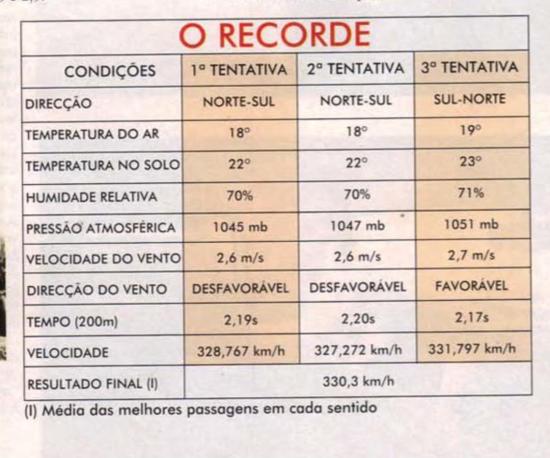
Crispi74 3w ago @196ss
I could answer you in two ways the easiest and the more difficult way.
One way would been around the figure dynoed when it was tested newer at Alverca running 2.5km at 330 kph(*)because closer to delivered engine parameters. More or less 630? But also less, if they used lower octane than engine required to perform its best.
Then. After 70000 kms at Ehra Lessein the car could be able to perform within the top of 5% as parameters of engine delivering were permitted with a much favourable torque curve after rebuilding. Who knows it could be able to deliver also more than 5%, if they use the advantage to add mileage to adjusting everything, I don't know how they start making the work using the term within specs.
It might not seem like it but it could be two very different things from when it was new concerning performance expecially if later, torque curve was favourable after shifting points so it's difficult to me guess a number like 650 or 670 because I'm unable to know how curves were varied or fuel used.
Are you, the more accurate on numbers. But, if the curves were fine I think I has said enough.It was a shame BM didn't dynoed their F1...
(*) Autocar XP4 did 322 kph in ~1.7km untill we doesn't know how torque curves affect its results and the reasons above.
196ss 3w ago @Crispi74
Thank you for your opinion. I can agree with you that a 1998 XP5 could have gotten a 5-7% power increase through mileage, rebuilt and tweaking parts, and extending rpm allowed.
However, I am not quite sure what you mean by "increased power within specs". To me, the rev limiter extension is already not a factory specs. It is also apparent that simply reprogramming ECU without making any mechanical interventions can increase the output. Whether this is a deviation from factory specs? - I think so.
Crispi74 3w ago @196ss
However, I am not quite sure what you mean by "increased power within specs". To me, the rev limiter extension is already not a factory specs.
This does means talking about engine spec only, limiter is to me a electronic factor, are to me two different thinkgs. I agree on the fact that mouve the limiter higher means alredy not to be within specs in term of electronic parameters..
It is also apparent that simply reprogramming ECU without making any mechanical interventions can increase the output.
It can increase power if the engine has power over the limiter, usually power drop down over the peak. In some cases this does means just revving the engine more higher..
However, I am not quite sure what you mean by "increased power within specs".
"Within specs" does means works rebuilding the engine with the higher torelance of production parameters. Or in one word massimized everything to highest level.
196ss 3w ago @Crispi74
As far as I understand it, ECU tuning is not only increasing the allowed rpm, but also adjusting the fuel mixture delivery, changing the ignition advance angles, and other things that will ruin your consumption and environmental friendly, but add torque in the range you need.
Crispi74 3w ago @196ss
I ask you guys now:
https://ibb.co/jZxykmJ
https://ibb.co/0cgKXcZ
What's the the power behind these variables? Looking into these details, studying better at these kind of factors behind mileage, or just a running in, or engine blueprinting, a world opens up.
This is why I always look at these things as main, discussing about performance between cars. Not to be a killjoy, what seems tuned could be even stock. We have to be good here to get the difference.
I'm not able with calculations but these are the differences with older and newer models both tested new:
https://ibb.co/hV364cH
It seems that 996 Carrera long term tested by C&D seems it start its life delivering less than 290PS closing its result at about 320PS after 40000 miles. Autocar seems to test a car that was delivering at that moment under those conditions, someting like 340PS or so, looking both for a fast comparisons. Huge differences!
Crispi74 3w ago @196ss
Coming in topic look at what happened to the Laribiere McLaren F1 GTR #05R when in Mclaren dynotested the engine after racing 10150 kms:
I think they found no more that 590PS or so, from a GTR unit with racing mileage of a full season. Will it be due to unbridled use?
I'm saying that becasue we can been in front that an XP4 prerformed as the powerful and newer XP5 after 24000 kms, but a GTR losted power then, after racing 10000 kms.
Confirming that every engine react mileage and use in its own way.
https://ibb.co/K0h6wQZ
Faster 1995 GTR was rated at 665PS before LeMans the same year. 633PS the 1996 GTR car. So it seems tha somes BMW engine had impoved its power during the mileage, other units seems the losted power during long use..
Entyring into the specific the faster F1GTR in LM1995 was the winner car #01R that was used as preseason testing car so, with surely a low mileage or as brand new engine for the event. Pre season car was surely the F1 GTR fitted with the very early 636PS GTR unit. A reason that maybe addressed to rebuilt the XP5 engine after 77000 kms for the top speed run was maybe due to the fact that in McLaren they were sure its engine wasn't in the conditions to deliver all the power requested to push the F1 at its top highest speed as possible. As like I suspected these engines comes to be prolonged powerful during mileage based on their use, then the power will start to drop down very easily. I believe when they tested XP4 they were sure to hit the best from its engine, was not properly the same when they choosed to try the top speed record run with the XP5.
That's why I believe the XP4 was able to deliver something like 630PS when it was tested, instead they had available way less than 600PS for a stressed engine like that in the XP5 after 77000 kms.
196ss 3w ago @Crispi74
Yes, the new 911 from the C&D test does look slow, even slower than the 993. There is an impression of quite a big difference in power with a mileage car, maybe around 10%. Surprisingly though, it doesn't affect top speed. As for the Autocar numbers, for me they seem a bit too fast for this car. I don't know if it makes a serious difference that this car has the optional shorter 3.95 final drive, but according to the AMuS numbers for the 986/996 models, it seems almost as fast as the Turbo: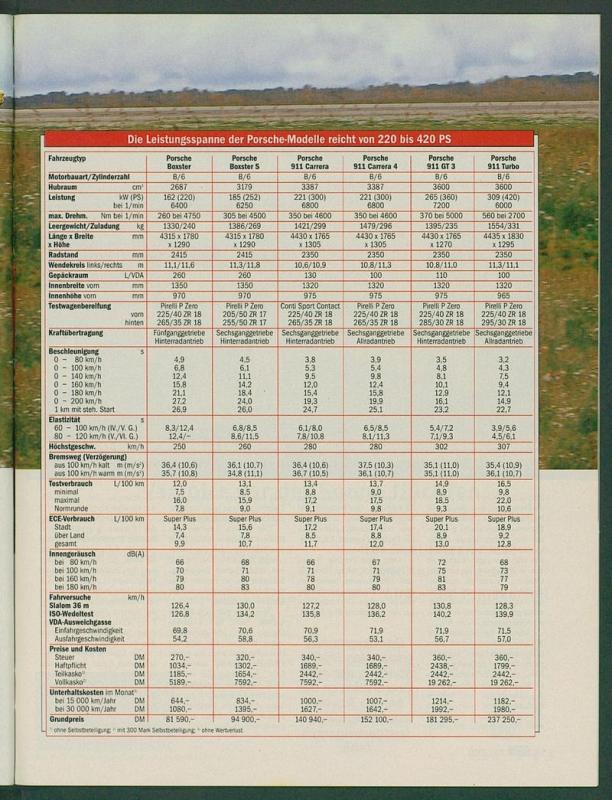
I've looked on the forums, and many owners of particulary 996 Carrera with the 3.4L M96.01 engine report a significant improvement in performance after 15-20k mileage. As a guess, perhaps the performance issues with the new engines are due to the fact that the liners and cylinder wall clearances were originally designed too small due to the use of that Lokasil coating:
https://prestigeandperformancecar.com/porsche/porsche-m96-engine-guide/
Although in the other example of the M96.03 3.6L engine you gave, there is almost no difference in performance. Perhaps the reason is that the clearances were corrected during the design of this engine, or due to more intensive use, the engine has already started to lose productivity by the long term test time. No one can vouch that for 40,000 miles both cars were used exactly the same way.
I can also share a personal experience. Previously I had a Porsche Boxster with the M97 2.7L engine, which is constructionally similar to the M96. I bought it in 2014 with ~12000km mileage, and we parted ways in 2020 with ~41000 on the odometer. In my subjective feeling near the end of the ownership, its performance declined somewhat. I've done some measurements, I can look them up if you wish. But there will be pretty hard to tease out the mileage share of the performance change along with other conditions. In addition, during my ownership the wheels were changed to a larger diameter, the transmission repaired and the clutch disk replaced, which probably also has an effect.
I might also add that not long after I bought it, I did a power measure at the Winde SuperFlow dyno and got 222rwhp. As I was told by the dyno staff, and as I was sure myself until recently, the engine was underrated from factory. My guess now is that if the transmission losses were on the order of 10%, the power was around the claimed 245PS.
196ss 3w ago @Crispi74
As for the F1 GTR, yes, the power drop is probably due to wear, which occurs due to the fact that the racing engine spends most of its short life working at full throttle. As far as I understand, initially the F1 GTR engine was considered reliable and economical compared to competitors (mostly turbocharged). I think it was a rare sight to see any other engine could withstand a full season.
Crispi74 3w ago @196ss
https://ibb.co/GWFnHN0
https://ibb.co/W50yV2x
https://ibb.co/Jv996yL
https://ibb.co/jhbCMHP
https://ibb.co/9GrVTVb
https://ibb.co/pd1kDVH
This is the Ameritech F1. What do you think guys about that car?
196ss 3w ago @Crispi74
Ameritech was rated at ~550PS and was a bit heavier. The test was done in very hot conditions so I guess it's capable of better acceleration numbers.
The top speed of this particular #42 car was tested by Mario Andretti at Fort Stockton. It was 217.7 mph gearing limited with 240 mph speedo indicated.
Crispi74 3w ago @196ss
I'm asking what Ameritech changed in terms of engine to be legal in US. What a strange car. Meaning, I wouldn't want the engine specification to go back to the first 550PS prototype units for these 7 cars in the way to push less power to reduce emissions maybe? I never understood how they mouved into that spec, if they addressed it in a less aggressive VANOS.. Weight seems to be 25kgs heavier.
Crispi74 3w ago @196ss
That's what I found in the second R&T article of the Ameritech I own.
This does suggest that due to the 102°F the car was tested we can assume that ¼ mile from 11.6@125 became to be 11.2@~134 if we applyed a correction as C&D usually does. That's more inclined to be closer to figure claimed.
196ss 3w ago @Crispi74
Meaning, I wouldn't want the engine specification to go back to the first 550PS prototype units for these 7 cars in the way to push less power to reduce emissions maybe? I never understood how they mouved into that spec, if they addressed it in a less aggressive VANOS..
Well, the Ameritech car complied with emissions legislation in the R&T test, while the standard F1 looks like didn't.

So, this probably confirms that some changes have been made, perhaps a somehow different cats design. Maybe these changes also caused a predisposition to overheating? The prototypes were known to cope well with the heat in Nardo and Namibia.
In any case, there was a rumour that only 2-3 of the 7 Ameritech cars were actually converted. The rest were either untouched and legalised "for company" or were returned to standard specs immediately after US Federalization.
Crispi74 3w ago @196ss
From homologation paper of the Mclaren F1 the correct tranfer gearing is 21/27 or 1.286:1
So gearing seems to be really a bit shorter than the published in Autocar data panel.
3rd gear will close 193 kph @ 7500 rpm.
When hit 201 kph does means access will be 7800 rpm.
Top speed runs will been more like:
XP3 to run 371 kph will be have to access to 7800 rpm.
XP5 to run 391 will be have to access to 8200 rpm
Ameritech with Andretti will be have to run 7350 rpm.
Calculated speed with tire size 2.246m. So Palmer seems to push closer to the limiter.
196ss 3w ago @Crispi74
Yes, but the wheel circumference of 2246mm is not a constant.
Dimensions may vary by manufacturer and specific tire model, but are marked to the nearest multiple of 5 sizes.
For example an actual 313/44 and 317/47 will be both labeled 315/45, but the actual diameters will be different.
As I have written before the top speed runs at Nardo and Ehra-Lessien (not sure about the acceleration test at Millbrook) were done on specially designed experimental Michelin XTL tires, presumably the larger size.
So I estimate kmh/1000 rpm at 49.0-49.5 for the Michelin and 47.0-47.5 for the standard Goodyear Eagle.
There also could be variances depending on tire pressure.
196ss 3w ago @RickyAstle98
Do you account for the increase in wheel diameter due to centrifugal force in your calculations?
Temperature inside the tire also rises, hence tire pressure increases. For example, if the temperature inside the tire rises from 20 to 100 degrees Celsius, the tire pressure increases by 27%.
According to my calculations, when the wheel rotates at 50 revs per second, the profile can increase by up to 5% depending on the rubber characteristics.
196ss 3w ago @Crispi74
Dimensions may vary by manufacturer and specific tire model, but are marked to the nearest multiple of 5 sizes
Here is an example. The calculated wheel circumference for the F40 335/35ZR17 should be 2093mm, but factual listed in the manual are - 2035 for Goodyear, and 2015 for Pirelli:
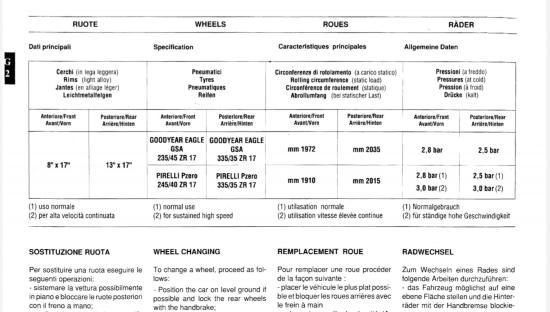
Crispi74 3w ago @RickyAstle98
My final verdict about Ameritech F1 >
With perfect conditions and professional driver onboard >
0-60mph@3.2s
0-100mph@6.8s
1/8@7.4s@106mph
1/4@11.2s@133.4mph
0-150mph@14.1s
0-200mph@31.1s
That results cannot comes from a engine delivering just 550PS IMO.
That 0-300 kph will be more like 24.5~25s.
Crispi74 3w ago @RickyAstle98
At that poin you must conclude how calculations close the fact with XP3:
0-96 under 4
0-160 7.0
0-200 less than 10
WHP? Consider the XP3 was really lighter.
I want to know how collimate with 580PS claimed.
Top speed at Nardo semes need more power.
Take 160 and 200 as more fixed time, the 0-60 does not make much sense imo.
Crispi74 3w ago @RickyAstle98
I will do excel table today with different weight and powercurves, XP1 to F1, AMF1 etc etc with times!
Good idea!
So XP1 was dynoed new 550PS
It was weighed 1003 kg dry.
Crashed in Namibia
XP3 was dynoed new 580PS
It was weighed 1018 kg dry
0-100 7.0
0-200 9.9
XP4 was dynoed new 607PS
It was weighed 1067 kg dry
0-300 22.4
XP5 was dynoed new 627PS
It was weighed new ~1100 kg dry
0-300 23.0
0-330 2.5km Cx 0.39
Ameritech etc.
The goal was to know power and how increase the engine from new. Just estimate will be a goal.
Crispi74 3w ago @RickyAstle98
After 30000kms this car cant go better
What's you tecnical reason that it should be different from a Mclaren? On the contrary turbocharged cars usually had small cleareance on piston rings to hold turbo pressure, so mileage affect frictions here, surely no less than N/A engines.
Crispi74 3w ago @RickyAstle98
Looking at the difference 196ss calculated for 506 to 663PS, ~0.8s = 25PS to 260 kph.
But here also the fun aspect, 0-260 kph:
Cargraphic 24.1s = 600 km mileage
Auto 20.06s = 9000 km mileage
Cargraphic conditions were no bad (18 deg C, ~1012 mbar or so). Auto magazine power car was calculated in 4th ~ 500PS.
That variable seems to me undercontrolled that I don't use calculations. Why that happened?
Crispi74 3w ago @RickyAstle98
I'm sure on the fact that, when Cargraphic F40 was delivered, the car was an early produced exported to Japan. That period F40 engines were deliberated from dyno test room as 478PS worst result. So, from Cargraphic to Auto examples I'm pretty sure there were non more than 25 or 30PS of difference. Unless Cargraphic car running 200kph 12.2; 0-260kph 24.1 was really something wrong that day.
Crispi74 3w ago @RickyAstle98
I was saying that sometimes variances are not so easy to explain. CarGraphic F40 was tested with a passenger, Auto was just the driver, CarGraphic conditions we known as no bad, Auto and
Quattroruote were tested bad conditions. That does I'm asking was the fact that CarGraphic car was slower to 260 kph by 4 seconds, to 280 kph by almost 6 seconds and its power was delivered surely no less than 478PS for the period produced.
That fact let me think.
Crispi74 3w ago @RickyAstle98
either this is something that defies the laws of physics, or it is also mathematically incalculable!
We are often faced with these situations expecially with brand new cars.
We know for sure that engines must be respect production parameters before to be delivered to be fitted in a chassis, so they cannot be delivered underpowered expecially of cars that F40 at the period. My conclusion is that mileage doesn't affect just power peak is evident.
If very low mileage (600-900kms) F40s like tested by Quatro Rodas or Cargraphic shows so slower 200-260 kph times this does means that something happens to be faster later into the 5500-7500 rpm averaged power band accumulationg mileage.
196ss 3w ago @RickyAstle98
Probably would be useful - https://youtu.be/dERvKWbMOhQ?si=2frNJOQ56N0U0qXi
Crispi74 3w ago @RickyAstle98
Here Carobu dyno, the stock blue curve:
http://a1222772.sites.myregisteredsite.com/F40%20LM%20510hp%20dyno.html
If that curves will produced 240-260 kph 5.7s if alredy a goal fo us.
Crispi74 3w ago @RickyAstle98
Between Sportec and Carobu dyno there was way more.
Sportec tops 646 Nm @ 5000.
Carobu was down to 380 lbft, 515 Nm @ 5000
That does means 92PS instead of 32PS on top high revs.
What's running in or milage will do inside at an angine was not properly add power peak but most of the affect will be addressed to lower internal friction so the engine will go up faster more than produce higher power figures.
196ss 3w ago @Crispi74
That period F40 engines were deliberated from dyno test room as 478PS worst result
With 2 people onboard and measuring equipment, I estimate the test weight at 1450kg. In this case, the peak power at the wheels is about 412PS (410 with temperature correction), max torque ~500 Nm. All this probably corresponds to the claimed figures on the flywheel. But, this car has a lot of power drop in the mid-range. Whether the cause is insufficient running-in, we will never know, but it can certainly be one of the reasons. If there were some other tests of this particular car would be interesting how it evolved.
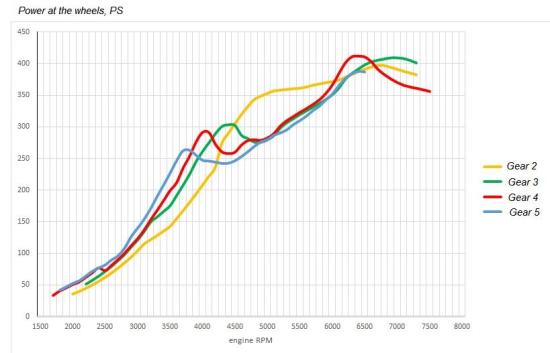
Also, judging by the fact that when accelerating through the gears the car noticeably losses the pace up to the higher revs (120-140 in 2nd and 180-200 in 3rd are slower than when accelerating from a dig), I suspect possible issues with the turbos.
Crispi74 3w ago @196ss
That CG was uncat car, but it was slower than some catalyzed.
Looking better at your diagram and it correlated with older ones that CG car deliver up to ~503PS and ~62kgm, but it deliver its power with a torque hole in the middle range because I'm pretty sure its running in must be completed. Ferrari had delivered it because engine was within parameters for the delivery.
AutoHebdo tested also a catalysed cars with almost the same numbers. QuatroRodas, Brazilian magazine tested one, uncatted car with 600 kms running 1000 meters 21.83@250 on hot conditions.
Possibly it was that 530PS BM Tubi exhaust car?
Yes exhaust was afternarket but pay attention, not sure if that dyno figures were corrected.
Crispi74 3w ago @196ss
Top speed Yatabe KPH:
F1 335
F50 306
EB110 GT 309
F40 317If there were some other tests of this particular car would be interesting how it evolved.
CG car did 300 kph at Yatabe, but I'm sure with mileage it will be able to run ~315 kph range as all the other BM F40s did.
196ss 3w ago @Crispi74
Returning to the F1 topic:
top speed runs at Nardo and Ehra-Lessien (not sure about the acceleration test at Millbrook) were done on specially designed experimental Michelin XTL tires
Don't know when this pictures were made, but I think I see the Michelin chequered flag and the word "Pilot" in these photos.
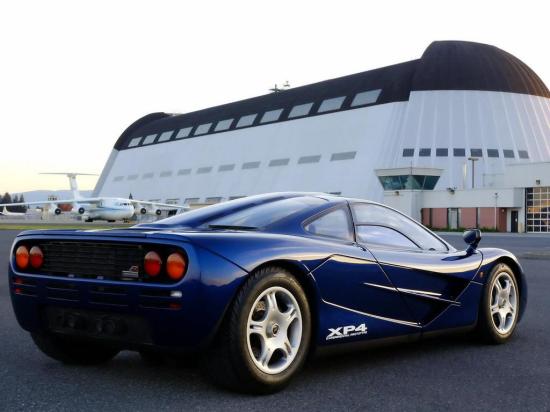
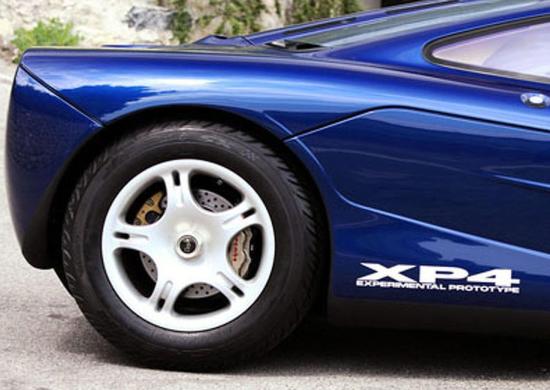
Crispi74 3w ago @196ss
Don't know when this pictures were made, but I think I see the Michelin chequered flag and the word "Pilot" in these photos.
The XP4 was sold late 1993 to a NewZealand ower. He asked before to refurbish the car repainting blue with new beige interior, new front and rear bumper as production spec, then it was tested early May 1994 . I'm unable to kwon these pictures when they come from which period for sure. In the picture taking the rear it seems the plate was deleted with photoshop but it was already registed evidently. The car was delivered to him later mid 1994, I believe the car was delivered with new tires to him. These pictures doesn,t sound to be tires with 15000 miles on them. Looking at picture at Bruntingthorpe doesn't seems to me the same tires, it seems they are Goodyear tires as when it was tested with the Jaguar at Motor Revue.
196ss 3w ago @Crispi74
Thanks for clarification!
Looks like Michelin Pilot SX tires are what cars usually got after MSO restoration.
One more thing that would be much appreciated if you could clue me in.
We know that after the rebuilt, XP5 set records at the Millbrook and MIRA speed ovals. We know the numbers, but I don't have much to compare it to (other than the XJ220S which itself is largely a cat in a bag). Probably you have something for other cars there?
Crispi74 3w ago @196ss
I'm not impressed by the CTR speed at Yatabe maybe due to the fact that 911 aero and weight distribution was not the ideal compromise to run fast on banked corners at Yatabe, what do you both think?
CG tested a weak CTR (tested at 1 bar), but BM tested a powerful car but on partially wet.
Crispi74 3w ago @196ss
We know that after the rebuilt, XP5 set records at the Millbrook and MIRA speed ovals. We know the numbers, but I don't have much to compare it to (other than the XJ220S which itself is largely a cat in a bag). Probably you have something for other cars there?
Let me check if I can found something.
196ss 3w ago @Crispi74
I'm not impressed by the CTR speed at Yatabe maybe due to the fact that 911 aero and weight distribution was not the ideal compromise to run fast on banked corners at Yatabe, what do you both think?
Yeah, I'd say the F40 and F50 speeds look higher than expected. While the others are hitting around 90% of the top speed, these two are more like at 95%.
Probably at the banked section both Ferrari could be faster due to more downforce. That's probably the main reason, although I don't exclude also that Best Motoring Ferraris were slightly tuned.
Crispi74 3w ago @196ss
although I don't exclude also that Best Motoring Ferraris were slightly tuned.
I think they weren't. The F50 was tested conditions very fine for combustion.
https://ibb.co/dmtGjsW
Air temperature 10°C
Air prressure 1024 hPa
Humidity 24.7%
The F40 with 317.8 kph was sligtly faster than 315.3 kph car that this F40 was tested in the standing km 20.60@261,5. https://www.youtube.com/watch?v=XGulwRcAb5I
A couple of document I own claims that cars were provided of just an aftermarket exhaust.
https://ibb.co/tmq8BJB
https://ibb.co/ZVSfndL "This F40 is normal except to changes the extaust system.."
https://www.youtube.com/watch?v=gwmDQNnoek0 F40 up to 313.6 kph.
https://www.youtube.com/watch?v=PjwzB0xl3sI&t=329s F40 with cats up to 308.6 kph.
Probably at the banked section both Ferrari could be faster due to more downforce.
Yes I think they are more balanced there on fast banked sections and F40s were about 20 kph less faster than the CG F1 at Yatabe.
Crispi74 3w ago @196ss
F50 306 kph was made by CG or BM?
CG :)
Can you esaminate better at that F40 313-317 kph compared to the 335 kph of the CG F1? Is there a way? or not, whit no any info about banked exit speed? I'm saying that becasue it could be interesting to know how these cars accelerate from 260 to around 315.
Crispi74 3w ago @196ss
Yes it should be, not necessary to know an accurate idea, just to understand.
From the videos it seems that the speed corners for the Ferraris was in the region of 250 kph.
https://ibb.co/wNd798y
196ss 2w ago @GTR35
I don't mind fanboism, even though it's ridiculously stupid at times.
What's really annoying is the haterness. I will never understand why somebody likes car A hence hate car B.
Cars are different, and that's the upside. For example, Porsches are known to be beautifully engineered and sophisticated, while the TVRs are just a rabid chariots that want to finish you off. I've tried them and I loved them both.
Crispi74 2w ago @196ss
And analysis is also the ability of noticing and evaluting details, one of that the CTRs tested at Yatabe were not fast as other CTRs, as example the Yellow Bird #01 tested by R&T seems it was fast as 29s to 300 kph. Or the CTR #29 tested by EVO was fast as 0-200 mph 35s. So if these cars were to Yatabe, we would have seen higher top speed of them.
I don't mind fanboism, even though it's ridiculously stupid at times.
The problem is when people doesn't admit the truth. Yes we can have two different point of view, looking in a detail that's normal, but usually these kind of people comes to see what is not true.
I have discussed with one of these because he was saying the F1 has the best handling due to fact that Tsukuba lap time could be increased down to 59 secs. The video of the time attack was showing a lap on wet track for him, instead the reason of the light of the headlights on the asphalt was linked to the fact of reflection during the twilight phase of the evening. He was trying to evidence some traces of humidity pulled up by the from the tires of the F1 during the lap when BM claims the asphalt surface was dry. Or the test made at Estoril was done with the newer configuration of the track for him, proving his theory on handling right, when telemetry was easily showing that lap comes from the older track by proving data by g force alalysis. He was trying his theory that the F1 was lapping a longher track and so faster. Or trying to prouve Nring lap 7.11 with nothing of concrete using unfonded video details or stories. Or the Bedford lap, not taking into account that the car was addressed to the track use using different angles than standard, harder setup of suspensions, more aggressive tires sized 18" and a sport exhaust. That's attitude is crazy! I find interesting when people examine, not when people talk about because folklore says! I love evaluating the qualities of a car, but also the limits! Talking with fanboys is always the same story, it's best because its best!
196ss 2w ago @Crispi74
Can you esaminate better at that F40 313-317 kph compared to the 335 kph of the CG F1? Is there a way?
It makes for an interesting picture.
McLaren F1 could be travelling down the banked section at 237 kph. In this case:
Acceleration 237->335 kph ~1380m, then braking 335->237 kph ~220m if we assume deceleration intensity of ~1g.
Maybe the cornering speed is a bit higher considering safer braking, but in general it should be around 240 kph I think:)
Going 237 kph at this radius, the lateral overload would be 0.99g. If you factor in a 30 degree of banking angle, that's equivalent to 0.86g on a flat surface.
When calculating the F40, if we take our 506 PS dyno calculation model, the corner exit speed must be at least 289kph to reach 317.8kph:
Acceleration 289->317,8 kph ~1530m, then deceleration 317,8->289 kph ~70m taking deceleration intensity ~1g.
This gives a lateral acceleration of 1.47g (equivalent to 1.27 on a flat surface).
Let's assume they were testing a stronger F40. The Sportec F40 (let's call it that) had an average of 492PS in 6600-7300 range (289-318kph). In order to have 270 kph at corner exit, the average power in the 6200-7300 (270-318 kph) range would have to be around 515 PS (i.e. peak would be ~530).
In this case:
Acceleration 270->317.8 kph ~1490m, then braking 317.8->270 kph ~110m taking deceleration intensity ~1g.
Lateral acceleration 270 kph is 1.29g (equivalent to 1.11 on a flat surface).
I hope I have made it clear. If something isn't understandable, please tell. I'll try to explain it up in more detail.
196ss 2w ago @Crispi74
The problem is when people doesn't admit the truth.
It's great that you're trying to get deep into the physical essence of things, and you're doing it dispassionately. This is really very commendable.
In my experience, the vast majority of people don't want to think. They like to fantasize more)
Crispi74 2w ago @196ss
Everyting clear! Thank you. I think the car will be more in the range of 530PS, the other exit speed seems to me too high. We already seen F40 dynoed by BM quoted 530PS. The only detail that doesn't match is that car ran 20.8@254 with their roll out.
Regarding the other argument, I retain that being impartial it brings you closer to the true meaning of things. I have always been attracted by the physical side of things, seeking the truth in my own way, on results I can't complain. I'm particularily passionate of these period cars, I own many cars I love, so I have no reason to don't look at the truth. Modern cars are more sofisticated, advanced and effective but are unsensed because they are without soul and history. Excluding for fast experiences they aren't what I look for and not to collect.
Crispi74 2w ago @196ss
The only detail that doesn't match is that car ran 20.8@254 with their roll out.
https://ibb.co/cgVpY1S
I don't know if a gearshift to 5th gear affected the speed here, these 254 kph aren't there to match as I would.
196ss 2w ago @Crispi74
The only detail that doesn't match is that car ran 20.8@254 with their roll out.
The first example covers 400-1000 m stretch in 9,1 and tops 315. The second - in 9,3 and tops 317.
Supposedly there could be a bit different characters of the torque curves, or maybe the second had higher peak power, but it was more prone to turbo lag.
Correct me if I'm wrong but I guess that more productive exhaust will increase the turbo lag since exhaust gases would leave more freely.
Modern cars are more sofisticated, advanced and effective but are unsensed because they are without soul and history.
I'm 100% with you in it.
Modern cars are too similar to each other. And the hunting for the big performance numbers coupled with mandatory safety and environmental requirements leads that they are usually not that interesting emotionally.
Crispi74 2w ago @196ss
Supposedly there could be a bit different characters of the torque curves, or maybe the second had higher peak power, but it was more prone to turbo lag.
Correct me if I'm wrong but I guess that more productive exhaust will increase the turbo lag since exhaust gases would leave more freely.
Your could be a reason. But what I found is that BM or Autoworks trap speed are always low, here some examples:
F1 276
F40 254~261
993GT2 233~244
Diablo 236~241
512TR 230
XJR15 237
F355 226
348TB 212
It seems like the final speed was an average more than really top end figure. The problem is that looking at their system always they used photocells instruments at the end of the km. So averaging the speed it seems not an answer.
Crispi74 2w ago @196ss
If we check the F1 trap speed result was 276 kph in the run the car made 1km 19.54 secs but looking at onboard video sequence it seems hit the limiter in 5th gear just before the finish line (it's more comprensible looking it at the 19.76 run). We know from CG its revs limiter was higher. So the question remains here how they menage their top speed?
196ss 2w ago @Crispi74
Looking at the video, it seems like they used radar, which is mounted roughly in line with the cones and finish fixing laser equipment. However, it's possible that the speed detection is taking place at some point in distance from the finish line.
Unfortunately I can't find detailed descriptions of Best Motoring's test procedures on the internet, but they almost never detect trap speed at 400m.
Allow me to clarify, are you sure that CG 5-58 and BM #12 are the same cars?
The colour and interior look different.
Crispi74 2w ago @196ss
Last 10 meters seems made in about 0.131s = 274.8 kph
https://ibb.co/V2KSqkf
https://ibb.co/R0V0nRK
So speed they checked are correct using laser.
196ss 2w ago @Crispi74
Found some interesting info on one of the forums:
"McLaren F1 #73
1998, 63rd car built, Candy Orange (AMG Green Velvet) - +5000 km | HDF & LM-spec | GT interior | "Q43 1KC" Florida (USA) or Europe
This is one of the very last F1 road cars built. And is one of only two standard F1s to receive the full power LM upgrade (680hp according to published sources). It also has an LM front splitter and rear wing and is painted in bright orange, similar to the historic Orange used on some genuine LM cars.
Inside is generally standard F1 with the addition of a GPS system. Seat materials and trim are raised nubuck/suede leather."
It turns out that the LM spec engines were installed on the two road cars near the end of the production run. Since they were apparently produced in parallel with the rebuild of the XP5, this again suggests me that some LM components may have been used in the restored XP-5.
There are photos on the page below, and it can be seen that the underhood doesn't look much different from the standard F1 and XP5 prototype.
https://www.ultimatecarpage.com/chassis/2371/McLaren-F1-073.html
196ss 2w ago @Crispi74
if you look at the screenshots I made a rude check considering that last distance from dashed line was 10m just by quick proportion with the car lenght. Nothing of very accurate more than taking it a little for granted
Not sure this could be an accurate tool for speed measuring. But still interesting
196ss 2w ago @Crispi74
I already know these two F1s with LM spec engines fitted. Which detail intrigues you into the specific? I'm sayint that becasue I'm not sure we can try a conclusion looking at external pictures of the engine, or something you found different?
Just a reflection.
If I were making a major rebuild of the car intended for a record run, I would use the best available for a road model.
Crispi74 2w ago @196ss
https://supercarnostalgia.com/blog/mclaren-f1-lm
What I always found strange is that F1 #73 was still using cats, the F1 LM was partially decatted using tiny units.
Just a reflection.
If I were making a major rebuild of the car intended for a record run, I would use the best available for a road model.
Good reflection, but we must to know how they can been mouved into that specification. We must to know how F1 spec ended and it start LM spec and how they managed that point. If they cheated or not.
Crispi74 2w ago @196ss
https://www.hagerty.com/media/buying-and-selling/mclaren-f1-lm-could-sell-for-20-million/
That's the other F1 with LM spec, #18
I add about the XP5 engine rebuilt, we must to know is they just checked into the engine or if they rebuit it and how they rebuilt it. The book said more like they checked into spec. More I cannot say.
196ss 2w ago @Crispi74
F1 #18 was originally produced in 1994 as a standard road car.
It received the LM-spec engine during the conversion in 1999, along with HDF-kit and new paint.
Damn interesting what exactly they did to the engine. Or just an ECU software upgrade and bigger radiators could produce that result?
Crispi74 2w ago @196ss
Looking into detail, the GTR was made developing the map of the standard engine adding the straight exhausts. The LM was the GTR engine developed remapped back for road use, using smaller cats and soundproofed exhaust.
The F1 with LM engine option seems are claimed full spec fitted, but looking at the rear part of the exhaust solution seems more close to the standard spec with bigger cats. Then, looking at pictures provided by Mclaren for the XP5 during top speed run, expecially one pictures indicated that cats were the same as standard. I don't know tollerances but, if we take everything into account cosidering if that Mclaren cheated about a forced map into XP5 I think that was alredy lower powerful than they rated for a full LM engine spec.
Crispi74 2w ago @196ss
The point on the XP5 engine used for the top speed run and what can be done behind it, my point of wiew said that we CANNOT know how they had mouved, if they addressed into checking and balancing high tolerances of very mileage fast engine or rebuilding it as new with LM spec using the manage of the mapping it, but at the same time,looking at pictures and sound published, they were forced using standard cats and exhaust. On both cases, the engine will not deliver 627PS as base claims but neither 680PS of an LM full spec.
Here we can only stay at what they claims, they were saying to push their top speed limit with a car within standard specs. Then, who knows.
My point of wiew is more inclined to think that they don't used any tricks with LM spec into remapping the ECU otherwise that does means cheated even in front of themselves. I'm more inclined they used the very highest tolerance looking at balancing and checking every engine part, and looking if everything worked fine, perhaps replacing worn parts into a mileage engine, then rebuilding it at its best and making it work best as air fuel mixture, ideal balanced compression, perfect cams aligment and so on. That does means to squeeze even way more that 627PS. But anyone is free to think differently. I try to explain me better. What sense would it have use tricks, maybe having the way to reaching legally the same power?
Coming back to Japan F1s, I had lost in my mind that CG F1 was #16. I'm getting old. So, can we guess that from these two, there was an engine power variance witin production? Why not. Bscher car was timed at 19.9 who knows the final speed.
That speed of 276 made by #12 by BM was low conpared to 11.04->19.54 = 8.5 of segment time. If my tool confirmed that 276 was really the correct speed, AMS example for the F40 was not as far or really close to a weak F1. Unfortunately Japan tests made at Yatabe always are lacking of data.
196ss 2w ago @Crispi74
Judging by the difference in top speed at Yatabe (335 and 330 kph), car #16 is apparently 4-6% more powerful than car #12 (weather and passenger correction needed). And this hardly corresponds to a difference of 16 kph at a standing km.
Given the difference in passing time between the 400 and 1000 markers, which is 8.5 and 8.2 sec, I'd cursory guess a trap speed difference of 8-10 kph.
I still find your initial suggestion of underestimated trap speeds in the BM tests more plausible.
Crispi74 2w ago @196ss
Are you sure the 330 kph reached by #12 wasn't indicated by the dashboard speedometer?
I say that because traslating subtitle in the video from Japan to my language that was the result.
If speedometer indicated ~330 kph this does means that right speed was ~320 compared to the 335 kph that CG reached with accuraded Correvit system back of the car.
That doesn't exclude that BM estimated trap speeds were too low at finish line of 1000 meters.
Crispi74 2w ago @196ss
We can only mouve around that fact that when Wallace tested his top run at 391 kph he said that the XP5 tacho was reading 400. So quite reliable, but who knows about tacho accuracy of the singular car into the specific.
Anyway indicated 330 suggested less real speed ofcourse.
Crispi74 2w ago @196ss
I would like to exclude that its speedometer error in our example car was that bad, top speed will drop down to real 300 kph or so, I don't think so.
There will be a small vantage of running top speed at Yatabe compared to the 317 kph of their faster F40 for sure. I hope for them. But that comparison between a weak F1 to a fast F40 even on fast straight segments opens our eyes.
On the other side, I would like to know more info than SportAuto published on the Bscher car.
Article is short and fast, summing up said that he constantly he drove the car daily from home to work, running fast up to 368 kph easily (article claims also 371 as top speed). The article has a data panel with verified data, and I was surprised when the first time I saw that 19.9 on their 1000m D.A. We cannot say much on that figure because we have not so many info at its regard, but it makes me think and intrigue because it was done with the right start.
196ss 2w ago @Crispi74
Top speed run near 400 kph reading I always thought was related with tires pressure or that tire expanding factor
I apologise, I didn't think of what I wrote here. I was probably half asleep already....
If the wheel diameter increases, the speedometer reading decreases compared to the actual speed. It's probably just that between 1994 and 1998 the XP5 speedometer was recalibrated.
There will be a small vantage of running top speed at Yatabe compared to the 317 kph of their faster F40 for sure. I hope for them. But that comparison between a weak F1 to a fast F40 even on fast straight segments opens our eyes.
I would attract your attention that the XP4 had the same time between the 400 and 1000 marks as #12. Assuming that the #12's worse trap speed at 1000 is compensated by a higher trap speed at 400, the #12 car should achieve 300 kph in 25 seconds or even more.
Using XP4 acceleration numbers we can estimate peak speed at Yatabe around 328-329 kph.
running fast up to 368 kph easily (article claims also 371 as top speed)
I suppose that was saved speedometer data, so nothing really useful in terms real speed of the Bscher's car.
Crispi74 2w ago @196ss
Assuming that the #12's worse trap speed at 1000 is compensated by a higher trap speed at 400,
This detail is really curious. This does say to us that 400m trap will be in the middle of 222 kph (Autocar) and 229 kph (CG).
We both know that must add a roll out from the 400m, because BM time were taken with laser, I conclude to say that looking that trap speed, it seems to be a car that ran fine to 200 kph followed by a worsening.
196ss 2w ago @Crispi74
But anyone is free to think differently. I try to explain me better. What sense would it have use tricks, maybe having the way to reaching legally the same power?
It will probably seem to someone that I have a tendency to overthink and build conspiracy theories, but I put the available facts together and the emerging puzzle draws me the following development of events:
The final XP5 prototype received a fully production homologated 627PS engine, but judging by the Bruntingthorpe, Alverca runs and C&D Top speed test it wasn't as fast as they wanted. At least the less powerful but lighter XP4 was quicker in acceleration.
In the autumn of 1994 R&T approached McLaren with an offer to take part in comparative top speed tests at the Ehra-Lessien. Despite the fact that the XP5 was available at the time, R&T was turned down, with the somewhat flimsy excuse that only Palmer was authorised for such runs, and he was busy at the time. What could have really dictated this decision? Safety considerations? Doubtful. The testing involved experienced drivers, and if the car had been damaged, McLaren would have been compensated accordingly. My guess is that McLaren was pushed away, oddly enough, by the possibility of competition. We know that the rev limiter would have prevented the XP5 from accelerating above 355-360km/h, and looking at Jaguar and Bugatti's results at Nardo it would suggest that they could have been close to that on the long straight, maybe even surpassed it. Especially, they didn't know for sure, Jaguar could have sent the S TWR or Bugatti could have sent the SS.
So they decided to go to Ehra-Lessien later on their own, utilising the full potential of their engineering project. I don't think Murray was behind that decision, I don't think he really cared about any records, for him it was all about the conception and all the other things were just side effects. It was probably Ron Dennis, or someone else close to the McLaren helm at the time.
So, near the end of the production cycle, the engine builders had accumulated considerable experience of produing and running race and road engines and had found a way to safely increase revs and find additional power reserves. Whether this was within specs or not, we don't know. We assume it was. But, that in itself, is a very subtle question, the lines are blurred, and everyone may look at it differently. At least, it is known for sure that 2 cars at that time left the factory with engines with a claimed power of 680 bhp. Whether this figure is overrated or underrated is unknown, but it's definitely based on some dynamometer testing. Exactly what differences there were from the standard motor is unknown, only a remapped ECU and larger radiators are reported. And with all that apparently, the power of the XP5 has increased significantly since the rebuilt. Within specs or not, again is another question with no clear answer.
Well, and that small but obvious tricks such as reduced ground clearance, special experimental tyres, and the removal of wipers, mirrors and sticker film confirm that McLaren was determined to make the most of every available little tool.
Feel free to demolish my hypothesis. It certainly has weaknesses technically, but, causally, it seems logical to me.
Crispi74 2w ago @196ss
My guess is that McLaren was pushed away, oddly enough, by the possibility of competition.
In McLaren they had always fear to compare the car with competitors, expecially for a lap time. Everything they did was addressed to be hardly compared. That's easy to suspect. I was young but I remember they attitude to approach their car on media.
But, that in itself, is a very subtle question, the lines are blurred, and everyone may look at it differently.
Yes, the difference here can be summarized on the fact that they take advantage by the experience accumulated during the production of their engines looking for the top speed run. And then they rebuilt the XP5 engine with some of their last advanced spec.
The truth yes, is that TAG engineers had put hand a lot of times into electronic of their engines running back to the BPR rules with air restrictors applyed. That's happened every year they raced BPR global championship or the FIA and more, they reprogrammed back the Ecu for the LM to be a road car. But here I stop me.
I never know about some development for production engine, talking of mecanical parts, excluding for the fact that 96 GTRs used high conpression pistons to compensate the lower inlet air permitted. And 97 GTR spec engine needed also to be reduced to 6.0l.
I know, as already said, that two production cars were delivered or upgrated with more powerful engines named as LM spec but believe me, I don't know how their racing experience during the years had pushed the XP5 to its limit. I can only say that cannot be excluded. Surely the base to used tricks, existed. Something specific should be found example regarding compression if they extended to higher compression pistons after the rebuilt or some compromising pictures like of map code if they used BUT I'm sure we cannot find nothing more than what they claimed as spec from the beghinning.
Crispi74 2w ago @196ss
I have not check into that tacho detail.
I was looking at your diagram interesting is the fact that top 522PS at the wheels tha XP4 delivered is basically around 45PS more than how Autocar XJ220 was itself delivering.TWR engineers said that this car was producing somewhat around 580BHP.
196ss 2w ago @Crispi74
Here's the Cargraphic diagram. The test weight taken as 1385kg, I didn't make adjustments for weather conditions.
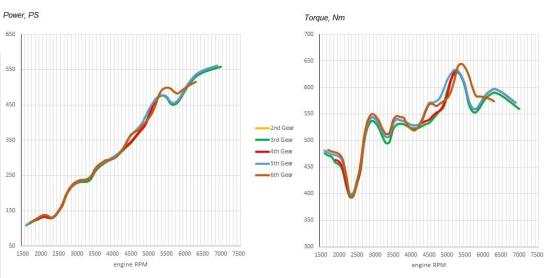
If I was able to correctly estimate the drivetrain losses, the maximum engine output under the test conditions turns out to be:
652PS @ 7400
717Nm @ 5500
After adjusting for 20 degrees it comes out to 641PS and 706Nm.
I think I've done quite an accurate calculation model of the McLaren F1 #16. My next step will be to calculate what acceleration and top speed figures #16 can show if I apply extended revs, aerodynamic tricks, and lower rolling resistance tyres to it.
That would be an interesting exercise in order to imagine was or wasn't XP5 engine tuned in terms of power.
196ss 2w ago @Crispi74
Wasn't possible to try an estimation for the XP4?
616PS @ 7500
595Nm @ 5500
I find it interesting to compare curves at low revs. The XP4 has a torque dip around 3500rpm. And generally the torque delivery seems unstable up to 4500. The production engine has over 500Nm at the wheels everywhere since 3000. I think that's what they've been working on in the final tweaking of the engine, and they seem to have been very successful at it.
Crispi74 2w ago @196ss
616PS @ 7500
595Nm @ 5500
That's very interesting. We should know conditions to DIN correct.
652PS @ 7400
717Nm @ 5500
After adjusting for 20 degrees it comes out to 641PS and 706Nm.
Just a thing. I don't know about correction you used.
652PS using DIN correction 8°C and 1022 mbar will come 632PS and 696Nm.
cf = (1013/P)×(T+273/293)^0,5
cf = (1013/1022)×(8+273/293)^0,5
cf = 0.99119×0.97930 = 0.97067
652PS×0.97067 = 632.8PS
196ss 2w ago @Crispi74
I used the equation of temp correction with the aspiration taken into account:
√(1-A×(Т×(Tn-Т))/(Tn×(Tn+Т)))
A - aspiration coefficient, in this case, for NA it's 1.0;
Tn - 293.15;
T - converting temperature in K.
In any case, the adjusted power is no more than 1-2% of the claimed one.
I expected more tbh...
Crispi74 2w ago @196ss
460PS@7200 at 102F
We doesn't know corrected air pressure, but with temperature power will come nearer to 475PS. I don't think the car will be less powerful than the XP3 taking in account everything.
In any case, the adjusted power is no more than 1-2% of the claimed one.
I expected more tbh...
That was a point where I wanted to take you. CG car wasn't that particularily powerful, it's just a production F1. That car was not so far from the XP5 in my opinion, just 3 tenths and 9 kph far at the 1000 meters finish line, w/o taking count of tricks.
Unfortunately we have no info on conditions during the test of the XP4. I expected more by the XP4 compared to the first impression of the XP5 and its dyno result to be the first engine unit delivering for sure 627PS (*).
(*) Evident that mileage doesn't means just peack of power, as explained by the analisys already made on the CG F40 ;)
Crispi74 2w ago @RickyAstle98
I understand that. What I cannot take for granted is the fact that we must cut so many horses to a car just because it was exported in US with no any prof that the car was mechanically changed. That's my point.
My point of wiew became particular by the fact here, that with no indicated any mechanical change, I'm inclined to think more it was just a weak car.
Crispi74 2w ago @RickyAstle98
Ok. But my curiosity goes farer. I'm asking it's a shitbox because it was added of a couple of bumpers and a couple of baggage instead of the seats?
Nothing claimed as works done to made it to pass US legislation more than that said. I would have imagined dealing with a mechanical problem to pass US legislations regarding pollution as MAIN point to loose power. Nothing of that was cliamed.
Crispi74 2w ago @RickyAstle98
I'm saying that above because I'm not sure by the fact that how they may changed in that car more than they should be done? I'm trying to explain better. Which kind of different ECU setting could be done or different spec of catalysts applyed more than the originals was possible by Ameritech, with just 7 cars managed to be imported? Who was Ameritech to menage those sensitive parameters to admit a Mclaren F1 in US? Infact nothing of that was mentioned or claimed by them and that's why its powerless could be indicated by another reason, imo.
Crispi74 2w ago @196ss
Evidently the peak of power was 627PS but curvers were not so efficently developed?
It seems strange if that engine was the unit of the official diagram.
I'm not sure at that point if there could be a mislanding coming from the engine production listed, starting from the unit fitted on Edward prototype.
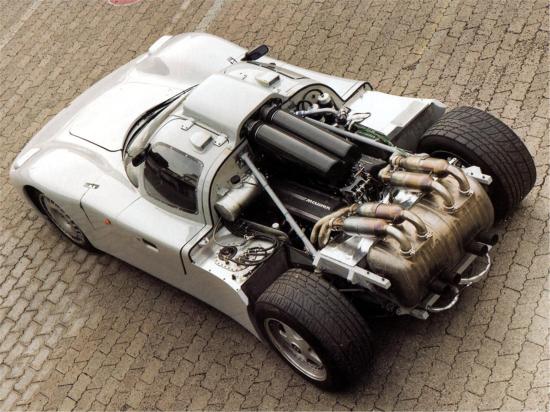
I explain me better. Official book Driving Ambition said that the story stated when the engine was early tested and dynoed to be developed, it did 627PS easily.
I wouldn't that engine was the really the first to produce 627PS and 680Nm. Then the development started furter producing units to be tested later and fitted later into XP1, XP3, and XP4. Producing as developed testing units figure as claimed 550, 580 and 607PS like Rosche didn't already decided which was the better solution to deliver to Murray.
XP5 was equipped with a unit delivering 627PS and choosed by BMW to be the definitive production spec but unable to deliver 680Nm as the figure achieved at the beghinning? Could that be a right sequence of facts? Who knows .
Objectively too many torque figures were claimed for those engines, I wouldn't want that XP5 unit was producing torque as much as ti be closer to 650Nm or less, with weaker nature of curve...but definitive setted for civilised on road factors for them?
The suspected fact for me remain a sort of too much coincidence to produce XP5 engine powerful exactly as the test mule engine. But, cannot be excluded.
Crispi74 2w ago @RickyAstle98
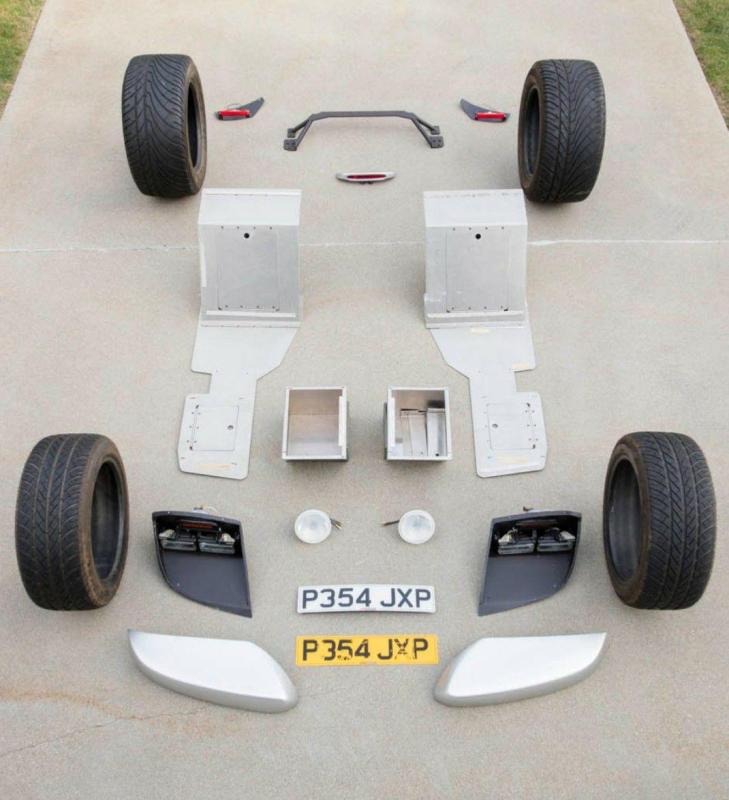
Coming back to Ameritech, that's the full kit.
Nothing that suggested to had changed something in the electronic of the engine or into the catalyst system.
The add of weight was rapresented by just the parts added as evidenced in this photo.
That is why those acceleration numbers comes from other reasons.
Crispi74 2w ago @RickyAstle98
Source Driving Ambition book:
Gordon: "BMW Motorsport had not begun work on the engine until March '91, yet by Christmas that year Paul's guys had the first prototype running on the dyno".
Straight off the assembly stand, that first engine bawled into Bavarian life as an exceedingly butch and bonny baby; almost immediately it out-performed McLaren's 550bhp target by 14 per cent-627-horsepower. It met the 600mm length requirement. There had to be a downside. With all necessary ancillaries, exhaust system and silencer attached it overshot the 250kg weight target by some 16kg. Gordon would forgive them that - 6.4 per cent overweight was more than compensated for by 14 per cent extra power.
His 'Brown Book' includes a justifiably excited entry for January 17, 1992. It read 'Munich all day - saw 1st engine - excellent meeting with BMW'.
On March 4, 1992 the first running prototype S70/2 V12 was delivered to Genesis to be prepared for installation in the tailor-made second test-hack, 'Edward'.
Crispi74 2w ago @RickyAstle98
And also by the book:
Much development was still to be pursued, although as much of Motorsport's tried and trusted technology had been employed as possible, basically to meet McLaren Cars' desperately tight time-scale.
While the S70/2's twin-overhead camshaft and 4-valve per cylinder valvetrain technology was shared with the high-performance BMW M3, the distantly related engines were tuned to significantly different torque characteristics. While the more mundane 'racer on the road' M3 saloon-car torque curve peaked at 3,600rpm, and was virtually flat from 3,500rpm to 6,000rpm, that for the F1 'driver's supercar' engine simply soared to peak at 5,600rpm, only 1,600rpm below peak power output.
But would this make the new McLaren like the Ferrari V12s which Gordon had sampled at the project's outset a ball of fire at descant revs but making much noise yet not doing very much below 6,000? Hardly.
Crispi74 2w ago @RickyAstle98
I forgot!
I double checked. Officially the power diagram disclosed by BMW was in BHP.
But figures were impressed in PS.
Power curve claimed 680Nm or 69.31kgm that delivered at 5600rpm was 542PS as figured by the diagram and not 534.5BHP. So 627BHP are 627PS here.
So initially this car dynoed 627bhp@7200rpm?
Dyno said 627PS@7400rpm.
Crispi74 2w ago @RickyAstle98
I'm still more inclined to think that XP5 engine unit st the beghinning was casually deliver the same power of the first engine fitted into Edward prototype, but something was different in torque curve nature making it much slower than it was delevoling 680Nm@5600rpm, example that partially could be explained by Autozeitung that said to be 663Nm@4000rpm maybe?
Crispi74 2w ago @RickyAstle98
I'm focused to understand the XP5 engine and how it deliver when it was tested by Autozeitung.
If the car was slower producing by the dyno 20PS more, and 196ss checked XP4 at 616PS; 595Nm when tested.
That does means to me torque XP5 unit delivered in the region of 580Nm@5500rpm or less.
As CarGraphic was expaining with the F40 testing cars too low mileage produced lower acceleration figures.
196ss 2w ago @Crispi74
The suspected fact for me remain a sort of too much coincidence to produce XP5 engine powerful exactly as the test mule engine. But, cannot be excluded.
That's an interesting assumption. However I thought Edward engine wasn't road legal.
...car was slower producing by the dyno 20PS more, and 196ss checked XP4 at 616PS; 595Nm when tested.
That does means to me torque XP5 unit delivered in the region of 580Nm@5500rpm or less.
Not necessary. In my view XP4 was about 8-10% lighter (supposedly with the full tank XP4 - 1170kg, XP5 - 1270kg). So, with the same output, or even slightly more, XP5 would be still slower.
XP3 claimed by AutoCapital:
580PS@7300rpm
62.9kgm@4000rpm
Wikipedia say XP3 had 433kW/589PS referring as a source "Autocar book".
Could you please clarify is it a mistake?
Crispi74 2w ago @196ss
Not necessary. In my view XP4 was about 8-10% lighter (supposedly with the full tank XP4 - 1170kg, XP5 - 1270kg). So, with the same output, or even slightly more, XP5 would be still slower.
I'm not able to follow you here, book said XP4 was 1067 kg dry, XP5 was around 1100 kg, a weight as intended for the production.
Why are you referring at 100 kg varied with full tank?
Wikipedia say XP3 had 433kW/589PS referring as a source "Autocar book".
Could you please clarify is it a mistake?
Autocar book said the power of the XP3 was 570~580 bhp. But every other mag I own that made a data panel of that car claims 580PS.
196ss 2w ago @RickyAstle98
Don't you guys think that looking at the chronology of XP5 tests one can think about some degradation?
Bruntingthorpe - 211mph at 2500m...
Alverca - 205mph at 2400m...
Autozeitung numbers better than Rallye Racing...
Maybe it's a coincidence, but could it be that the XP5 engine, being experimental, got quite heavy loads on the test bench, and was installed in the car showing 627PS already being actually broken-in? And then there was a gradual performance decreasing.
How you guys thinking that could be the case?
Crispi74 2w ago @196ss
Cannot be excluded. I only can say at regard that when Autocapital tested XP3 and was July 1993 the article said an engine producing 630PS was already dynoed and it's almost ready, so it was June. XP5 was completed 17 September. It seems that dyno process could be long?
Also unit one, it seems to was tested for long before to be found home in Edward.
Crispi74 2w ago @196ss
Maybe it's a coincidence, but could it be that the XP5 engine, being experimental, got quite heavy loads on the test bench, and was installed in the car showing 627PS already being actually broken-in?
That's what happened to engine number one, fitted in Edward.
Here from the book:
"The new power unit just proliferated with race-bred features, yet was very much a road engine. It had to be road tractable, moderately stressed to achieve a respectable service life and practicable maintenance schedules. In Munich Motorsport's engineers even put it through the same 500-hour bench test to which any other BMW road-going power unit would be subjected. Nominal service interval was settled upon as 5,000 miles."
I don't know if dyno process was the same, but XP5 engine seems it was processed over 2 months like this one, if it ran 500 hours at the dyno stressing the engine, obviously the engine was well broken-in and already starting its power degrade because we already seen the GTR unit loose power by 46 HP after more than just 10000kms of racing.
500 hours on the dyno bench will been equivalent a lot more.
The fact that doesn't convince me is the reason why give such a stressed engine to a new car, the XP5...ok it was the spec chosen to be the definitive for production, yes but why declare it 627PS to no longer be so?
Honestly I can't make this detail stand up without an engine rebuilt, on the other hand XP5 was addressed to be a marketing department car.
I would also have to answer what treatment the previous units would have had, and why.
Crispi74 2w ago @RickyAstle98
Maybe, but who cares about stressed engine back in 90s?
Maybe for prototypes? Maybe some of these prototypes? I'm sure production it didn't work like that. The product must be pass and respect a quality process. Do you think they delivered an engine to the customer with 500 hours behind it? Naaa.
At Ferrari, in 90s, an engine was tested 5 hours on the test bench, if everyting was fine into parameters, it was delivered to be fitted in the car.
If anything the engines fitted into Edward and XP5 may been had a longer dyno process to check and achive certain objectives precisely for the weaning of the first unit and the refinement of the last unit before the production line.
Crispi74 2w ago @RickyAstle98
500 hours running 100 kph are like 50.000 km, running 200 kph are like 100.000 km. For an F1 running 200 kph was 4000 rpm in 6th. A rpm range still contained.
The most part of the Ferrari dyno tesing was processing a range of 5000 rpm.
It seems to me a long peocess of engine life, for the F1.
Crispi74 1w ago @196ss
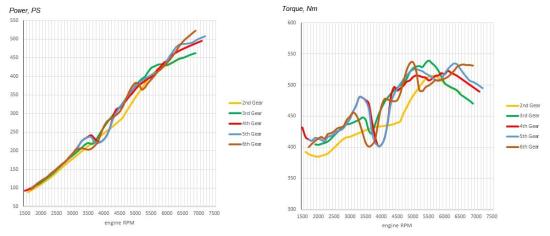
I was looking back at XP4 dyno simulation.
I want to point out a couple of details.
First of all, 3rd gear you referred I think it was related to 90-110 mph 1.7s in the acceleration in each gear figure. During acceleration from rest time was 1.6s.
Even worse, the 120-140 mph in 4th gear, was 2.3s vs 2.0s.
Because I think your diagram was taking into account each gear acceleration, I think that peak power of these two gears will been higher than evidenced by the diagram. Expecially looking at the 4th!
Crispi74 1w ago @196ss
XP4 tested with a half tank at 1138kg.
XP5 presumably weigh the same as the production car because there is no difference in specifications. XP5 dry weight is around 1100kg, i.e., 1140kg precisely. Same as standard road car.
F1 GT (the long tail) was claimed 1120 kg dry. Source, the book. I'm inclined to think dry weight for production short tail must be lower than 1120 kg. XP5 will be more like 1100 kgs as claimed there. The F1 GT road car had also the same 6.1l engine of the production cars, 18" wheels but the production car setup is the same. So 20 kgs more is more than justified, isn't it?
Another detail from the book:
"This pair of 'Heavenly Twins' completed a major carbon-clutch research programme (with more success than for carbon brakes), before 'Edward's back end was amputated again to enable the complete 'F1' powertrain/rear suspension assembly to be bolted-on more or less in its final 'XP' form.
Edward' was then shipped to Munich for BMW Motorsport's test staff to complete the thousands of kilometres' running demanded to prove the engine, to set service standards and to meet the myriad legislative requirements on exhaust emissions and related factors."
196ss 1w ago @Crispi74
The fact that doesn't convince me is the reason why give such a stressed engine to a new car, the XP5...ok it was the spec chosen to be the definitive for production, yes but why declare it 627PS to no longer be so?
Honestly I can't make this detail stand up without an engine rebuilt, on the other hand XP5 was addressed to be a marketing department car.
Maybe that's the answer? What better car to save money on than a car for the marketing department?
But I doubt in 500 hours as they test the first engine. More like maybe 100-200?
First of all, 3rd gear you referred I think it was related to 90-110 mph 1.7s in the acceleration in each gear figure. During acceleration from rest time was 1.6s.
Even worse, the 120-140 mph in 4th gear, was 2.3s vs 2.0s.
Because I think your diagram was taking into account each gear acceleration, I think that peak power of these two gears will been higher than evidenced by the diagram. Expecially looking at the 4th!
No, it's not.
Since my task was to try to estimate the maximum output of the car, for calculation I took the best acceleration figures on each section, both from acceleration on gears and basic acceleration measurement in a straight line. Same for the Cargraphic test.
However, I want to make sure you have an understanding that these graphs need to be considered in conjunction with the test weight figures I used in the calculation. Since the test weights are only for R&T, the others are my estimates based on the data in the article:
XP4 - 1138kg+driver+measuring equipment=1230kg
car#16 - 1263kg+driver+passenger+measuring equipment=1385kg
The point of my comment is that while test weights seem reasonable to me, we can't be 100% sure of them. So we understand that if in fact the test weights were closer, the power/torque curves will also lay closer. This will be especially noticeable in 2nd and 3rd gear. Although, at high speeds in 5th and 6th gears, the weight does not have much influence anymore.
F1 GT (the long tail) was claimed 1120 kg dry. Source, the book. I'm inclined to think dry weight for production short tail must be lower than 1120 kg. XP5 will be more like 1100 kgs as claimed there. The F1 GT road car had also the same 6.1l engine of the production cars, 18" wheels but the production car setup is the same. So 20 kgs more is more than justified, isn't it?
In fact, we don't really care about dry weight here, much more important is test weight.
Earlier we already treated with you the weight of a road F1 with a full tank as 1270kg. Accordingly, the XP5 should be somewhere around that.
ХР4 - 1138+45*0.74=1171kg.
Thus, depending on the difference in tank filling the difference in weight will be ~50-150kg, isn't it?
Coming back to Ameritech, that's the full kit.
Nothing that suggested to had changed something in the electronic of the engine or into the catalyst system.
The add of weight was rapresented by just the parts added as evidenced in this photo.
That is why those acceleration numbers comes from other reasons.
Some sources also report about possible under the skin changes. There are no specifics though, and it's probably just fog.
Nevertheless, it seems to me that $160,000 for all this "conversion tools" even including shipping seems like a rip-off.
Crispi74 1w ago @196ss
What better car to save money on than a car for the marketing department?
It could be.
Since my task was to try to estimate the maximum output of the car, for calculation I took the best acceleration figures on each section, both from acceleration on gears and basic acceleration measurement in a straight line. Same for the Cargraphic test.
Ok I get it.
Some sources also report about possible under the skin changes. There are no specifics though, and it's probably just fog.
I wouldn't that it feels that they were just rumors never confirmed. As it happens, these are discussions that arise from the fact that a US spec must be take for granted, a engine weakening.
I found interesting the fact that Edward engine was, after all, transplanted to the XP1, let me check how the car goes, becasue I own some data of that car running Silverstone during early track testing.
Crispi74 1w ago @196ss
On XP1 the book said:
"Despite the bitter cold of a January day on the deserted aerodrome circuit, 'XP1' first demonstrated hot gearbox oil problems. Yet even three-up it effortlessly hit 170mph along Hangar Straight. Gearbox proximity to the superheated exhaust catalytic converters was one cause. An oil cooler was added with its cool-air scoop just behind the engine intake."
Motor Tend said on XP3:
"On the run down to Stowe corner last week," reveals chief designer Gordon Murray, "our Formula One car was reaching 180 mph. On the same day, in the same place, in the F1 we were getting 173"
"The F1 truly wasn't de signed to chase these big numbers-they're simply a by product of its efficient packaging, 2244-pound dry weight and 580-horsepower 6.1-liter BMW V-12"
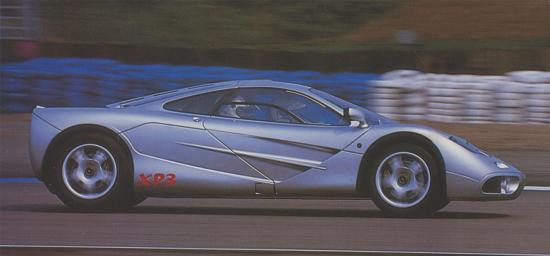
It seems that XP1 with its 627PS stressed engine, wasn't fast as the XP3 fitted with the 580PS engine.
Crispi74 1w ago @RickyAstle98
It's interesting for me to know how they mouve the development step by step, what they used and what they exploited. I think this part of development process of a supercar was the most interesting to know. Production process is always easier to understand why more linear and discounted.
I add also, confirm to me the fact that they used very mileage engines for testing prototypes is even a very interesting detail to know. Expecially to know that for XP1 and XP5, using the very first engine mule into the 1st prototype and the definitve specification into the last prototype.
Crispi74 1w ago @RickyAstle98
I forgot that Quattroruote did an article at the steeringwheel of the XP5, 12/1994.
Weight 1210 kg with driver
Acceleration claimed by the article:
0-100 3.5
0-200 10.0
0-300 22.0
https://ibb.co/0q188Hs
https://ibb.co/zF0z4pS
https://ibb.co/JdtNSDL
https://ibb.co/vBtmHKc
https://ibb.co/Nt09D7c
196ss 1w ago @Crispi74
I found interesting the fact that Edward engine was, after all, transplanted to the XP1, let me check how the car goes, becasue I own some data of that car running Silverstone during early track testing.
Sorry, I'm a little unclear on that detail....
The Edward engine was installed in the XP1 to replace the original 550PS engine? Or was the Edward engine received a new 550PS rate instead of 627 after being installed into the XP1?
Crispi74 1w ago @196ss
The Edward engine was installed in the XP1 to replace the original 550PS engine? Or was the Edward engine received a new 550PS rate instead of 627 after being installed into the XP1?
As far as I get Edward engine, the first engine stessed for long at the dyno already delivering 627PS was then fitted in the XP1 with part of rear suspension system. The new engine that story said to produce 550PS was fitted in the Edward prototype to pass BMW requirement tests. When XP1 was launched in the Hangar Straight was just fast as later was the XP3.
From the text, it doesn't look like they weighed the XP5. It seems they just took the claimed 1140 kg and added 70 kg of pilot. Am I wrong?
No they don't weighed it. The panel said 1100 kg on running order. But then they summarized 1140 plus driver.
196ss 1w ago @Crispi74
We know that after the rebuilt, XP5 set records at the Millbrook and MIRA speed ovals. We know the numbers, but I don't have much to compare
I would still like to go back and review those records as well.
In March 1999, the XP5 was accelerated to a top speed of 200.8 mph on the Millbrook ring, running the entire circuit in 37 seconds at an average speed of 195.3 mph.
It seems to me that higher speeds could have been achieved, but the limiting factor was the tires.
The lateral acceleration in this case would be:
V ^2/R = 15.65 m/s ^2, or ~1.6g
where V = 200.8 ×1.609344/3.6=89.7656 m/s.
R = 3235/(2 ×π)=514.87 m
In this case, a constant load of more than 2 tons (1.6×1300kg), of which most of it is on the right tires very quickly kills the rubber, which we can see in the video. Previous record was set by XJ220S TWR at 180.4 mph with lateral acceleration ~1.3g.
Possibly it is more interesting to consider the record set in December 1998 at the MIRA.
The XP5 completed a full lap in 1:00.56 with an average speed of 168 mph and a top speed of 196.2 mph. The circuit itself is a triangle with a banked bends.
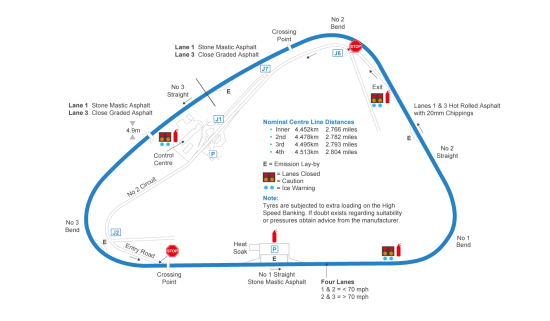
In my estimated reconstruction of the run, the cornering speeds should be at least 235-240 kph. Roughly it could look like this:
1. Bend 1 - length 500m, average speed 240 kph, time ~7.5 sec
2. Straight 1-2 - length 700m, acceleration to 292 kph, braking to 240, time ~8.9 sec.
3. Bend 2 - length 370m, average speed 240 kph, time ~5.5 sec.
4. Straight 2-3 - length 1200m, acceleration to 315 kph, braking to 240, time ~15.3 sec.
5. Bend 3 - length 540m, average speed 240 kph, time ~8.1 sec.
6. Straight 3-1 - length 1200m, acceleration to 315 kph, braking to 240, time ~15.3 sec.
It's apparent here that on the straights the XP5 is nowhere near as fast as it was during the record-breaking Ehra-Lessien run (seems even a bit slower than the #16 CG). Assuming the XP5 accelerates faster and slower in corners, we will ruin the ratio of the top to the average speeds on the track.
Accordingly I think this could be an argument in favor of the XP5's lack of mechanical modifications for the record run. But what happened at Ehra-Lessien, why was it accelerating so fast? In my opinion that aero tricks couldn't have given such a boost in acceleration.
Also interesting enough, previous record holder at MIRA was also Jaguar. It was XJ13 with 186 mph top speed and 161 mph average.
Crispi74 1w ago @196ss
But what happened at Ehra-Lessien, why was it accelerating so fast? In my opinion that aero tricks couldn't have given such a boost in acceleration.
Here what I thought on why that car was so fast. Again, for convenience I take definition from the web:
"What does a balanced and blueprinted engine actually mean? How do you balance or blueprint an engine?
Balancing and blueprinting an engine are two different processes that are often done together to improve its performance and longevity.
Balancing an engine involves ensuring that all moving parts, such as the pistons, connecting rods, and crankshaft, are of equal weight and are in perfect harmony with each other. This is typically done by carefully measuring the weight of these components and then removing material to ensure that they are balanced. Balanced engines tend to run smoother, produce less vibration, and can potentially last longer.
Blueprinting an engine, on the other hand, involves taking precise measurements of all engine components and then machining or adjusting them to meet exact specifications. This process aims to ensure that all components are optimized for performance and are consistent with each other. Blueprinting can involve optimizing clearances, adjusting tolerances, and ensuring that all components are aligned and assembled correctly.
Both balancing and blueprinting are typically performed by experienced engine builders or machine shops using specialized equipment and techniques. The goal is to maximize the engine's efficiency, power output, and reliability."
I.e. if you take CarGraphic F1 engine, you open it as it was new, and you rebuilt it with these kind of processes, balancing it and blueprinting it, it's from the beghinning I'm saying you will have a result of a maximised engine in terms of power.
Yes, that's evidently because also Bmw engines made specifically for the F1 were built along and assembled as a production line that certainly did not take these individual production processes into account in terms of building them singularily with that care.
Time, accuracy and money spent evidently, once the XP5 engine was singularily rebuilt to be addressed to find its best for top speed run!
Apart from this, comes into account the aerodynamic reasons.
I.e.bis, adding the fact that they can had the opportunity to check every engine parts using a well broken in engine, they may have had a particularly smooth and aggressive engine. If they didn't used tricks that's the reason.
It's apparent here that on the straights the XP5 is nowhere near as fast as it was during the record-breaking Ehra-Lessien run (seems even a bit slower than the #16 CG).
Accordingly I think this could be an argument in favor of the XP5's lack of mechanical modifications for the record run.
These are two very intersting confirmed points. Explain to us the fact that till that moment or at least, during these records the car perform in line as Autozeitung or Quattroruote mentioned to be fast.
196ss 1w ago @Crispi74
These are two very intersting confirmed points. Explain to us the fact that till that moment or at least, during these records the car perform in line as Autozeitung or Quattroruote mentioned to be fast
Well, we can look XP4 Autocar&Motor test:
150-196 mph - 13.1 sec ~1030m
braking 196-150 - 2.1 sec ~160m
Overall 1190m 15.2 sec (compared with 1200 and 15.3).
Autocar&Motor 200-300 kph converted from mph varies between 12.7-13.0 sec.
Autozeitung 200-300 kph - 13.1 sec.
So, I think, yes! Autozeitung performance fits perfectly!
Bmw engines made specifically for the F1 were built along and assembled as a production line that certainly did not take these individual production processes into account in terms of building them singularily with that care.
Honestly, when we're talking about a piece car with such a high cost, with probably about half of that cost having an engine, I would think that precision fit, weight balancing, etc. is inherently implicit in the manufacture. After all, this is an engine with outstanding performance for its time in terms of relative torque and power per unit displacement, and so I think the tolerances in terms of workmanship and fit had to be very tight.
Sorry, but if an engine becomes 7-10% more powerful after the rebuilt, it gives the impression of insufficient initial build quality. However that possibly was only XP5 problem since being a prototype.
Please, don't think that I'm arguing with you. Just stating my thoughts in favor of one argument or another...
Crispi74 1w ago @196ss
Please, don't think that I'm arguing with you. Just stating my thoughts in favor of one argument or another...
Don't worry, I know.
if an engine becomes 7-10% more powerful after the rebuilt, it gives the impression of insufficient initial build quality.
Come on, a main reasons could be due to a more aggressive cams timing it's a part of rebuilding a powerful engine.
Look at the very early GTR engine as example was dynoed 636PS, after adjustments deliver 665PS for LeMans '95.
From the book:
"Variable valve timing was featured, with an hydraulically- actuated phasing mechanism retarding the inlet cam relative to the exhaust cam at low revs, which would reduce valve overlap to ensure good idle behaviour and low- speed torque. Higher up the rev range, the engine management computer would command valve overlap to be increased by 42 degrees to improve engine breathing and maximise power output."
196ss 6d ago @Crispi74
Come on, a main reasons could be due to a more aggressive cams timing it's a part of rebuilding a powerful engine.
Yes, but that no longer fits the definitions of blueprinting and balancing that you cited above. In my understanding, that's tuning already.
But what happened at Ehra-Lessien, why was it accelerating so fast? In my opinion that aero tricks couldn't have given such a boost in acceleration.
Due to the results of the MIRA run consideration, my assumption has changed. I think the engine rebuilt most likely didn't add much power. Probably, as you wrote, it went more in the format - disassemble, check everything, clean, tweak, correct and reassemble as it was. However, during the Ehra-Lessien run it seems that some tricks were used to a short time increase in power. We can't know exactly what they did, only can guess...
It is possible that when reprogramming ECU, in addition to extending rpm, the fuel supply at high revs and ignition advance angle were also increased. Also possibly they used racing fuel and the air filter may have been removed.
After the record run XP5 ECU seems to have been reset back to the base settings.
Crispi74 6d ago @196ss
Yes, but that no longer fits the definitions of blueprinting and balancing that you cited above. In my understanding, that's tuning already
Hehehe. Here we come in the very hot argument, because what you are saying depends. It depends on how they had works on the parts. Working on parts within factory production tolarences doesn't means tuning. Does means works within spec.
Otherwise even any technical regulations would not make sense.
Here what the book said:
"On March 31, 1998, the meticulously prepared - but scrupulously standard - 'XP5' was driven in three serious- intent high-speed runs on Volkswagen's Ehra-Leissen test-track, cut through the forests near Wolfsburg, Germany."
"Painstaking preparation of a perfectly put together but utterly standard production-spec XP5' ready for the World Record-setting VW test track run."
Crispi74 6d ago @RickyAstle98
Well, thats power only for top speed runs, as I said earlier, 627wps is enough for top speed run.
Also seems high to me. It means as they would have deleted the transmission losses :)
How is possible to improve engine within tolerances, if they were working within spec, to the point of deleating that amount of losses?
196ss 6d ago @Crispi74
“utterly standard production-spec XP5”
It also depends.
I, for example, have my own grading. In this case considering bodywork:
standard new car appearance - stock;
no windshield wipers, no mirrors, film tape - tuning;
new aero kit (not stock) - modification.
Also with the engine. There are tuning, and there are modifications, the motor can consist of standard parts, but be tuned for more output.
I realize that probably, since it was an official record in the Guinness book, there may have been some inspection, and all parts should have been within factory specs. But, parts being standard can still be tuned for more performance, right? Hardly anyone has checked fuel consumption or emissions against standard F1 figures?
As time went on, the parameters checked, the rigor of their control, and the limits of what could be touched on the mechanics of record cars changed dramatically. Take for example the Mercedes 300SL, it is clear to everyone that no standard car could reach 261 kph, nevertheless, the fact that the manufacturer achieved this speed on his test track with completely unknown modifications of the engine and aerodynamics allowed to consider it a record fast car. Jaguar XK150 could accelerate to 150 mph only with a special aero dodger with a small flap instead of a windshield, but nevertheless it was considered a 150-mph car.
Move on, a much more standard but decatted XJ220 hit 349 kph, and this was also largely considered a record, although the car wasn't ever delivered to customers without catalytic converters.
And now the 1998 McLaren F1 run. Apparently, compared to everything that came before it, it's practically a stock car. But, if you look at it from a modern perspective - you get too much stuff that's tacked on.
The McLaren F1 is a great car, and generally most of all the happy owners loved it, because it was actually driveable and provided a terrific balance of comfort and thrills. With it's low weight, stiff construction and plenty of power the car had a lot of potential both on race tracks and in terms of top speed with fairly minor mods. But, we are well aware that a standard road car could never hit 390, nor would it be the fastest on the circuits.
Crispi74 6d ago @196ss
Automobiles Classiques tested the XP5 at 49678 kms in 1996:
https://ibb.co/prRHwkc
https://ibb.co/L6ZjYw8
https://ibb.co/D9TR1NL
Data panel claims:
0-100 3.4
0-160 6.4
0-320 28.0
1000m 19.6
Weight with full tank 1187 kgs
Crispi74 5d ago @RickyAstle98
What is really incredible is the fact that this engine produced that amount of power with catalysts fitted and without using a stright exhaust.
On the other hand, GTR engines with no restrictions produced in the range of 700PS or even some power extra, but the spec was worked to be really aggressive, using stright through exhausts and cats remouved. I always excluded the fact because reasons are here like doors closed.
Crispi74 5d ago @RickyAstle98
At that point we cannot exclude they find such a quantity of power fitting aggressive spec and also GTR96 higher compression pistons into the XP5 engine, but that was already use tricks.
Basically a GTR96 engine unrestricted but adjusted to be used for road.
F1LM engine was basically the GTR95 unrestricted engine, remapped for road using tiny catalysts and boxes into exhausts. But pistons were less compressed than the GTR96 spec.
196ss 5d ago @Crispi74
Automobiles Classiques tested the XP5 at 49678 kms in 1996
It's a somewhat strange article, thanks for sharing!
Seems like a lot of interesting info, but it looks like they didn't measure anything themselves. It is stated that the acceleration is provided by McLaren (selon constructeur), and also some other data is quite surprising.
Let's go in order:
1. Engine weight with accessories is 274 kg.
All sources seem to claim 266 kg. What accessory can weigh 8 kg is unclear, maybe the intake manifold?
2. Maximum torque is listed at 7000 rpm, this is also strange. If it's not a typo, then the power at 7000 rpm should be 647.8PS.
3. Regarding weight. It is not clear where the empty weight of 1080 kg is taken from. Nowhere else have I seen such a figure. 1187 kg weight with a full tank seems to be a calculated, not a weighted figure.
If we imagine that this is indeed the case, I can't understand why the XP5 is so much lighter than #16 and #42. It has a full interior and air conditioning, who can explain to me why it is 80 kg lighter?
4. Well, the coolest thing here is downforce. It is reported to be 100kg at 240km/h. Does anyone think that's too much for a standard F1? We can assume it's with the rear spoiler up, but then the distribution should be not 40/60%, but rather 30/70 or 20/80, no?
All in all, rather conflicting information in my opinion.
PS: I finally managed to get the book "Driving ambition". Will now read it time by time in my spare:)
Crispi74 4d ago @196ss
I list my impressions on the article:
It seems that the car was not tested by the magazine, but at the same time it seems to me that figures comes from something officially made, Autocar it seems was not the only referement by Mclaren and XP5 seemed to be verified more than one time.
1.The engine weight, yes, could be varied base on how weight was taken. Agree on the fact that weight added could be due to include the intake manifold. I saw several weigts, but 266 is the most usual.
2. It's not the first time I saw that torque was expanded to 7000 rpm, even Autocar claims that 479lbft were estended till 7000 rpm. I think it's just an official typo. There were like a couple of theories on these engines torque figures, one with a peack at 5600rpm, the other like it generate more like a flat torque in a crescendo from 4000rpm.
3. I also don't know where 1080 kg is taken from, but to me this figures make sense expecially if XP4 was definitive is not because of soundproofing panels. I'm not sure if XP5 1080 kg weight is really that correct, but surely non far from that. F1 GT was 1120 kg dry claimed by the book. You both always talk of full weights, and I get it but I prefere starting from dry weight because create less margin for error.
4. I always not so confident on how Mclaren claimed on downforce parameters, excluded when they started some figures for the GTR. Their data seems to me too much based on "abstracted data" compared on how visibly the car was designed to be.
Happy reading, Driving Ambition is a book to own.
Crispi74 4d ago @RickyAstle98
Anyway I don't stop to research something at regard of the XP5 engine history.
We must to know more on how and if the engine was developed using upgrated parts as higher compressin pistons.
They do these kind of upgrade, it was not the first time or I listen these things happens.
196ss 1d ago @Crispi74
So here's the power and torque graph for the XP5 in the record run:
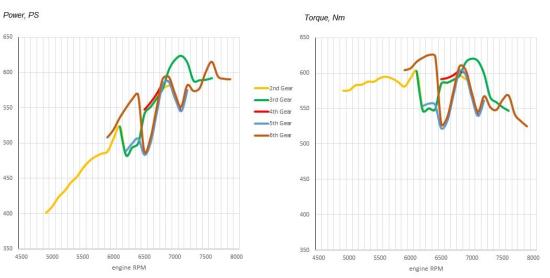
A few caveats:
1. Test weight 1350kg.
2. The CDA taken into account in the calculation is 0.54.
3. Michelin XTL tires with rolling resistance half that of the Goodyear Eagle F1.
4. When processing the data from the video, some partial acceleration figures seemed inaccurate by 1-2 tenths. In general, I was basing on the following acceleration data:
2nd gear
100-120 - 0.8 sec
120-140 - 0.5 sec
3rd gear
160-170 - 0.5 sec
170-180 - 0.5 sec
180-190 - 0.4 sec
190-200 - 0.5 sec
4th gear
210-220 - 0.6 sec
220-230 - 0.7 sec
5th gear
240-260 - 2.0 sec
260-280 - 2.0 sec
6th gear
290-310 - 3.0 sec
310-330 - 4.5 sec
330-350 - 5.2 sec
350-360 - 3.4 sec
360-370 - 4.2 sec
370-380 - 6.5 sec
380-386 - 6.2 sec
196ss 23h ago @RickyAstle98
What's wrong?
627ps@7400
I don't think peak power comes in that range, because 360-370 in 4.2 requires more power than 350-360 in 3.4. So on 6-th gear peak power would be at around 7600-7700 range.
CdA 0.531 (after aero tweaks)
What is your source on this value?
I estimate that aero tweaks lowered drag on ~5%. Probably more, but I doubt.
RickyAstle98 19h ago @Crispi74
I dont want, because McLaren lie to us and almost every manufacturer, doesnt make sense to do simulations, I know what the car capable of with or without wing and another elements, anyway I start compare F1 to Veyron, where Veyron cannot do 0-300 under 20 seconds on street surface, sadly enough, Veyron doesnt use full power out of Top speed mode, which activated by special key, thats looks like real Top Gear video, where Veyron was behind full 22 seconds! Someone says its fake and Veyron dont lose this race under real world conditions, exactly not, Veyron is heavy concord!
Crispi74 1h ago @196ss
https://ibb.co/3hqsSs6
https://ibb.co/R3pGf59
Here you are performance I own for the F1LM and F1GTR '97.
RickyAstle98 8m ago @Crispi74
600 bhp @ racing
704 bhp @ 7300 rpm (506 lbft) @ engine
950 kg dry (false)
Zerglin8759 8m ago
Gordon Murray speaks out after 32 years, the McLaren F1 was a big mistake and had tons of faults
https://www.caranddriver.com/features/a44928628/gordon-murray-t-50-tech/
wallenieswiftie 10m ago
0 - 80 kph 2.7 s
0 - 100 kph 3.2 s
0 - 120 kph 4.3 s
This car did 100km/h in first gear with a conventional manual transmission. This means the 80-120 time of 1.6 seconds is quite conservative. Theoretically it could even do 80-120 in 1.1 seconds with the right gear ratio — which would make it on par with a Bugatti Chiron or a Koenigsegg Gemera. But there's a little bit of truth to every conspiracy theory. Being a lighter-than-average 6-liter V12 car (and grand tourer at that) actually means less time to shift; basically the thing has got a racing clutch disguised as a street one. While the average manual takes .5 second, I'd reckon .3 or even .2 second to shift in the F1, judging by magazine and video tests in the past. The real 80-120 time is around 1.3 seconds — just borderline 720S and P1 territory!
wallenieswiftie 1y ago
The McLaren F1 was supposed to hit 85 mph in first gear, but most F1s were geared to hit only 65 (and sometimes even lower than that). The long-gear F1s can hit the same top speed of 243 mph as the (technically-modified) XP5 did.
wallenieswiftie 1y ago
I would be really surprised if this car was actually released in 1989.
wallenieswiftie 1y ago
Check out these in-house estimations
0-60 mph: 3.29 sec (pre-shift) or 3.81 sec (post-shift)
0-100 mph: 7.38 sec-> 60-100 = 3.57 sec
Street 1/4-mile: 11.47 sec @ 131.45 mph
Top speed: 228 mph (theoretical maximum velocity: 240 mph)
https://docs.google.com/document/d/1ERFzdIin1zS36ZjmkjahNwjwJAVxwoPCgNV2zJzn2Jo/edit?usp=sharing
Cocobe 2y ago
For all the comments about how the "F1 can't possibly only have 627PS" based on its acceleration figures and top speed: Yes and no. The engine is rated at 627PS, but it has a ram air roof scoop that can increase its power at speed. Possibly the car could have over 640hp.
Acceleration. you are comparing the F1's acceleration with cars like the 720s/765lt in terms of acceleration without factoring the F1 power to weight. The F1 weighed 1138kg WITH fuel, while a 720s will weigh well over 300kg than it. As Sir Issac Newton would put it. Acceleration = Force/Mass. So it only made sense that the F1 accelerated as fast as these 2 cars above 100mph.
Top speed: The F1 is MUCH more aero dynamically efficient, and it's a much smaller car. Just by that calculation, The 720s/765 may need 25-35% more power to match the same top speed.
Then it also depends on the gearing, as in does peak power arrive at top speed? Turbo charged engines get max power lower in the rev range and taper off towards the red line. The 720s when shifting to 7th gear, the car slows down due to revs being too low. But In 6th gear it hits 216mph around 8000rpm. Peak power is between 6500-7000rpm, and the car has 50hp less above 7500rpm. Meanwhile the F1's peak power arrives at the red line, precisely at peak power because it's a N/A engine.
The F1 had so little drag and downforce that the car would start moving around above 200mph. Today's cars are much bigger, heavier, stable, safer and care more about cornering grip, hence need a lot more power to move.
Whatever 2y ago
A hidden gem. Comparison between Enzo and F1 on a track by Rosso Magazine.
https://youtu.be/09dkIvb4zcU
As for lap, there isn't a recorded one. But based on segments, approximate but not exact measures.
Enzo: 1:08-3:41
F1: 5:14-7:46
